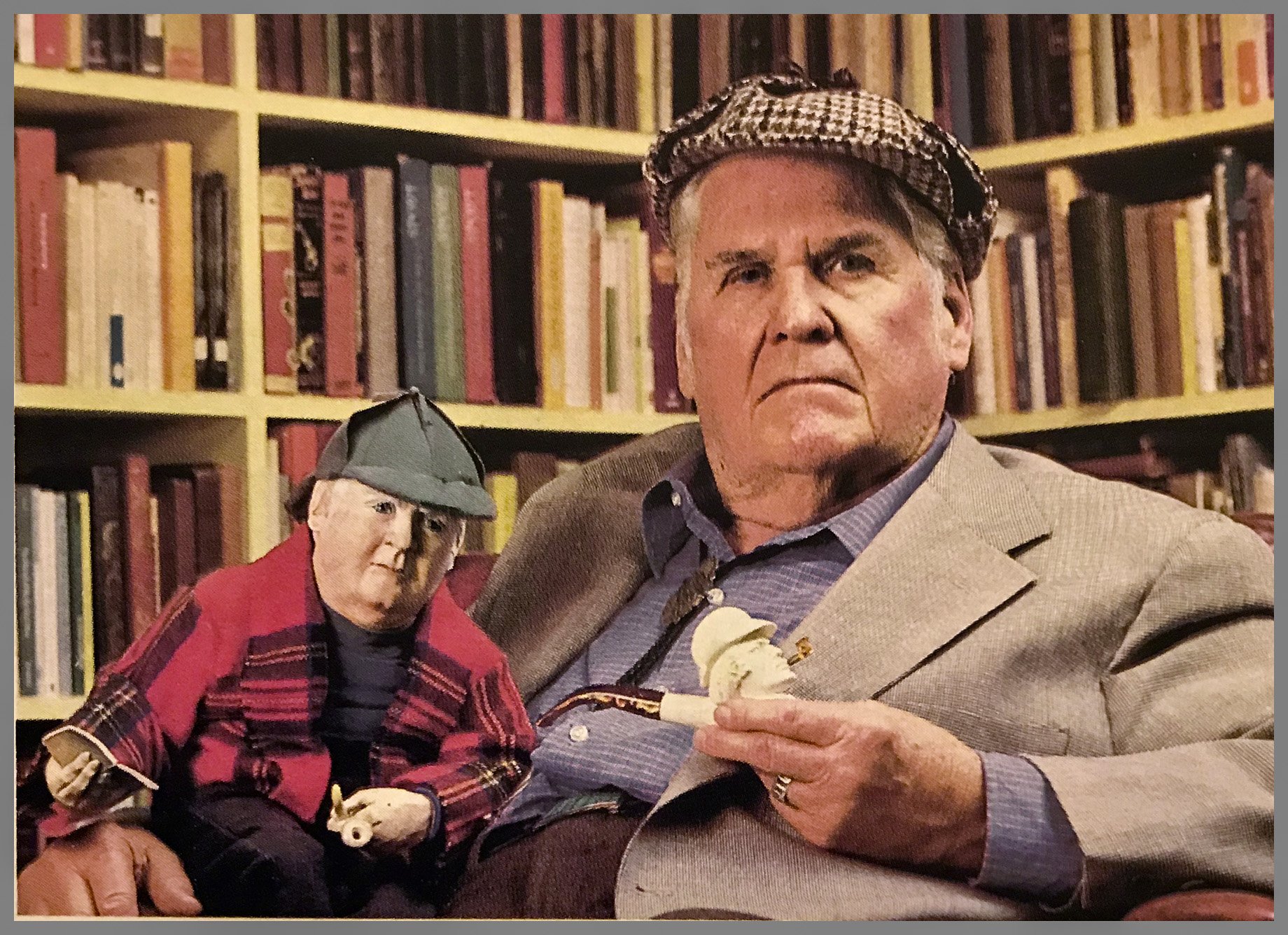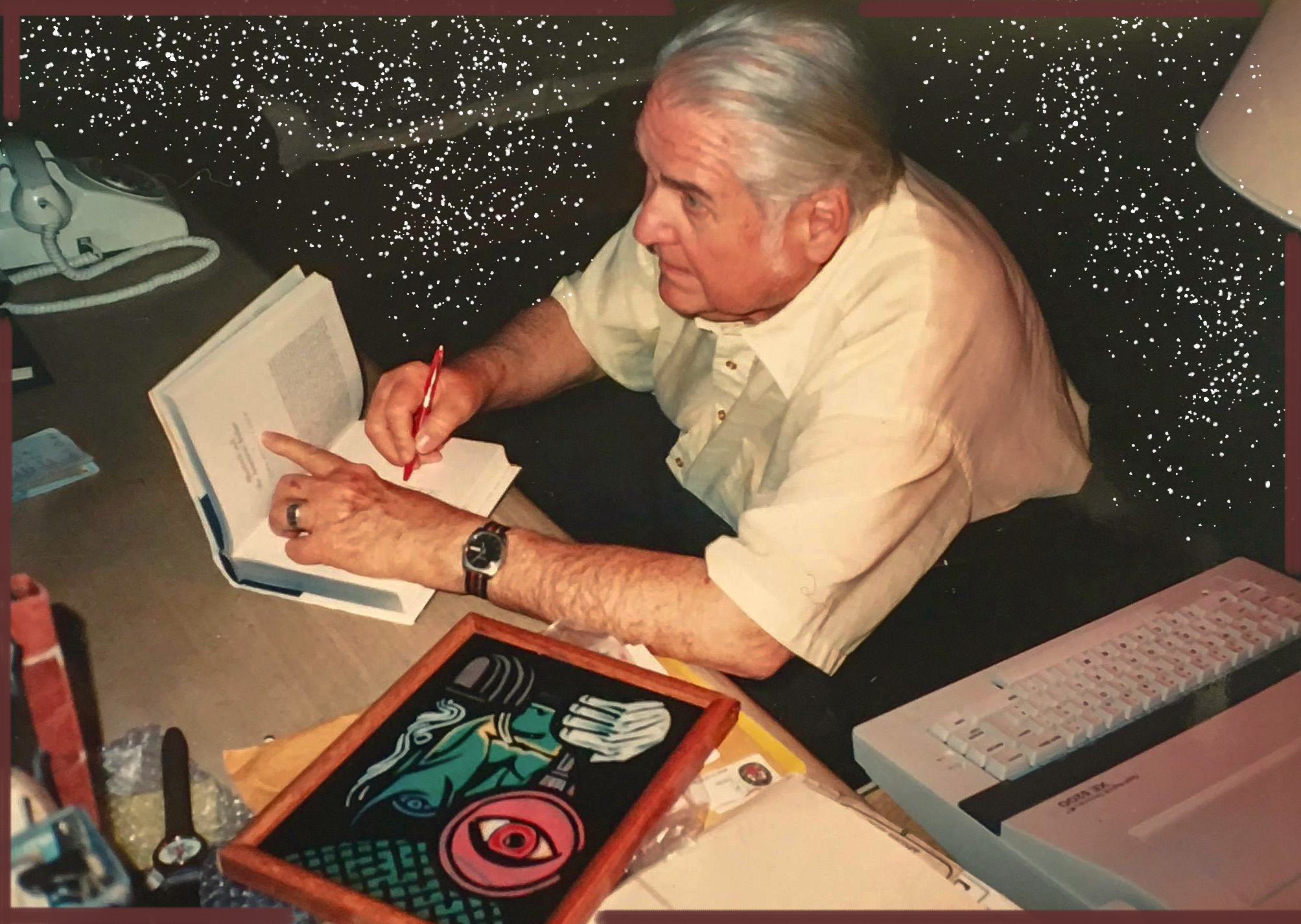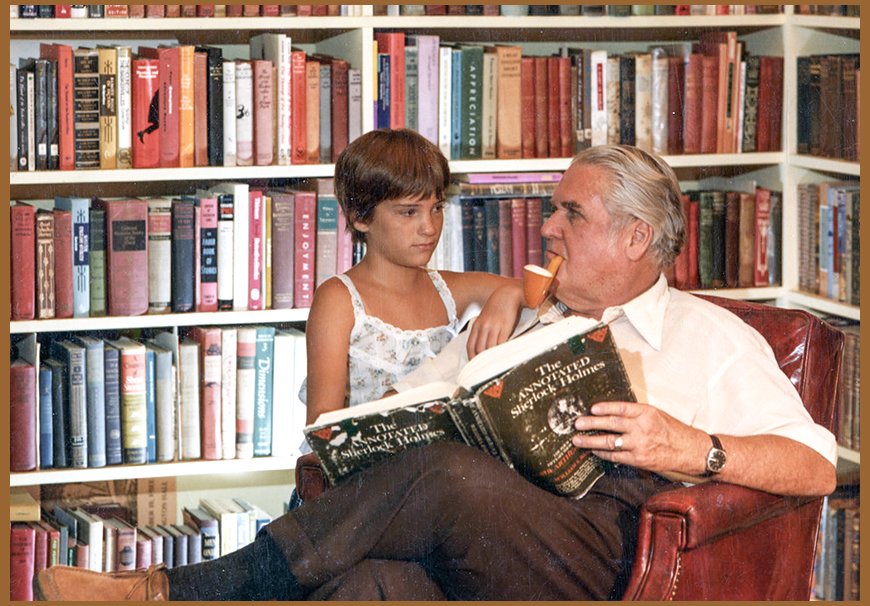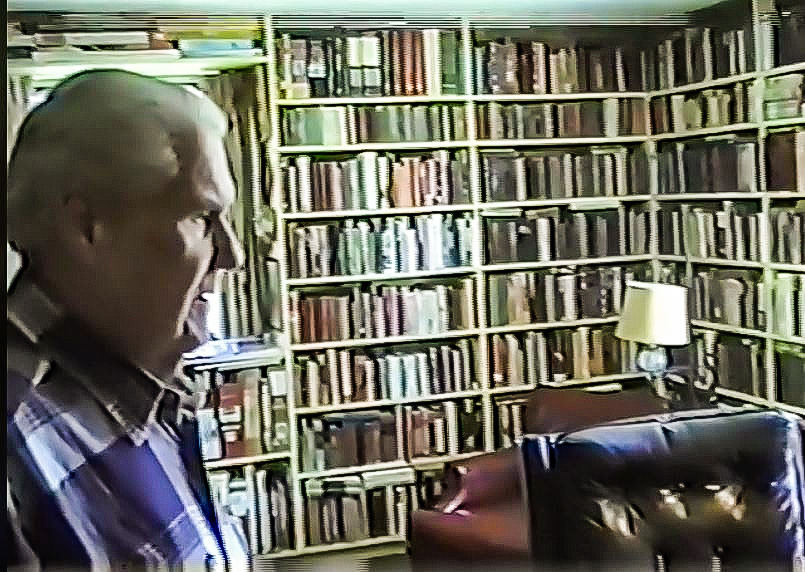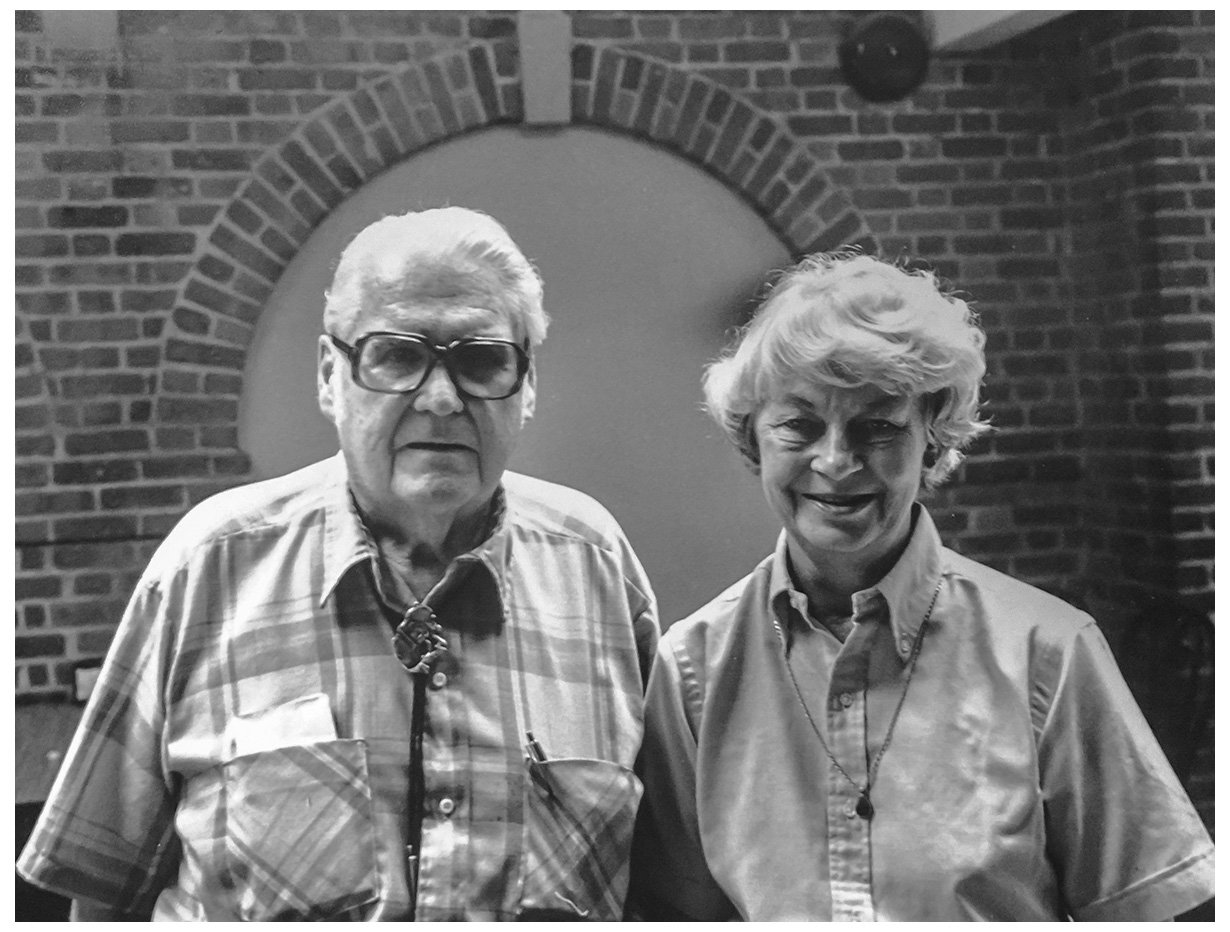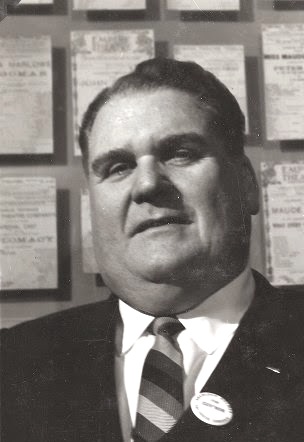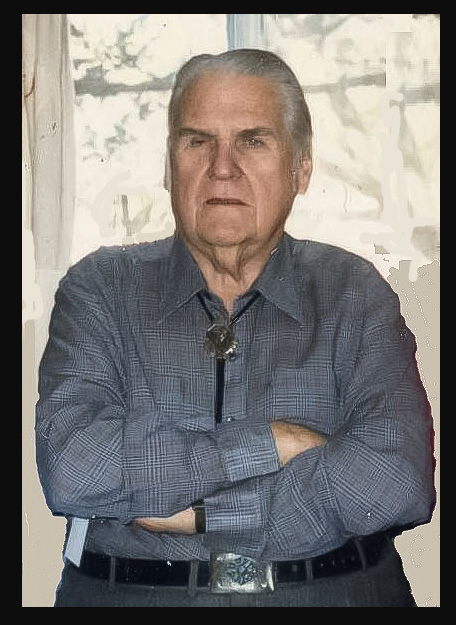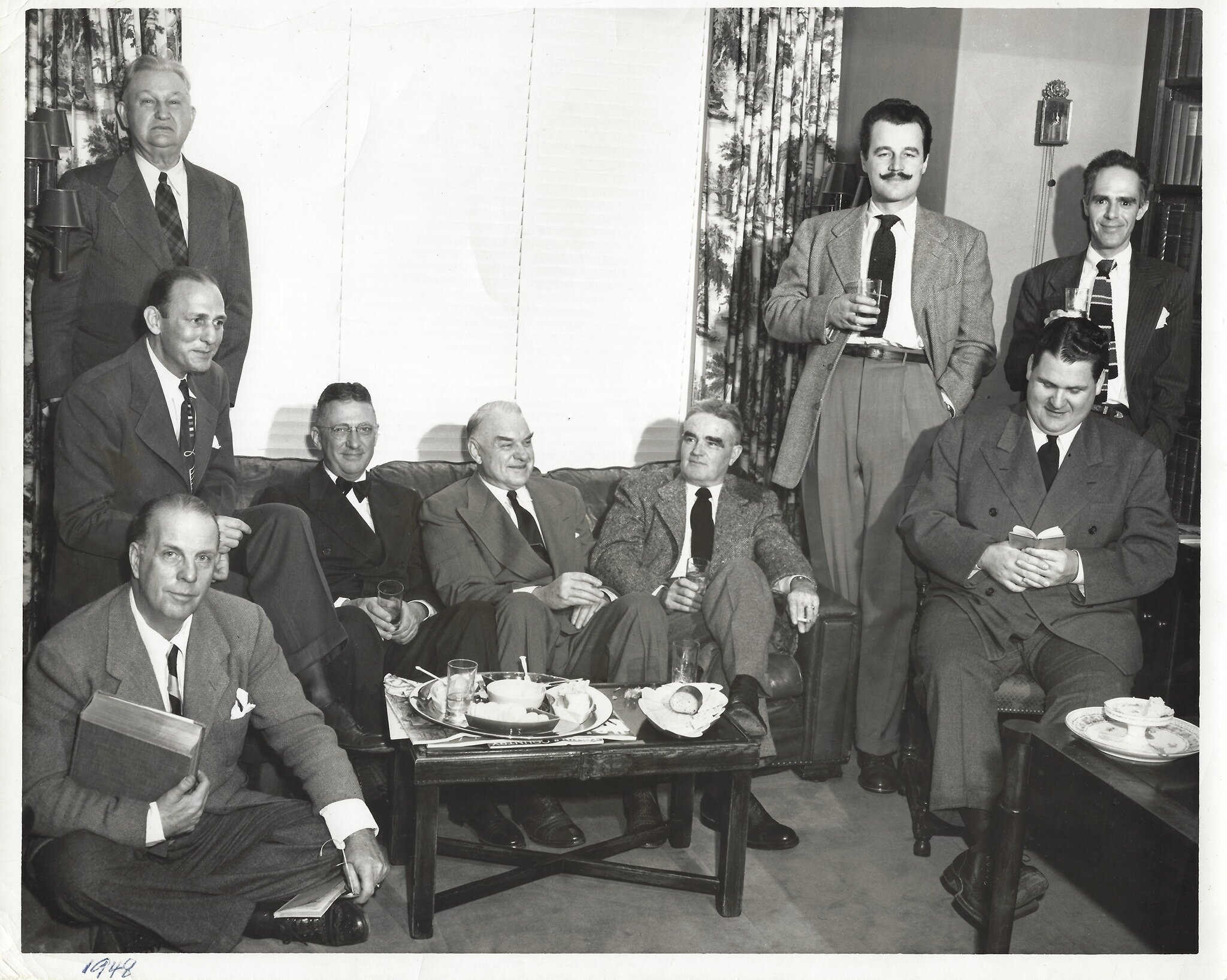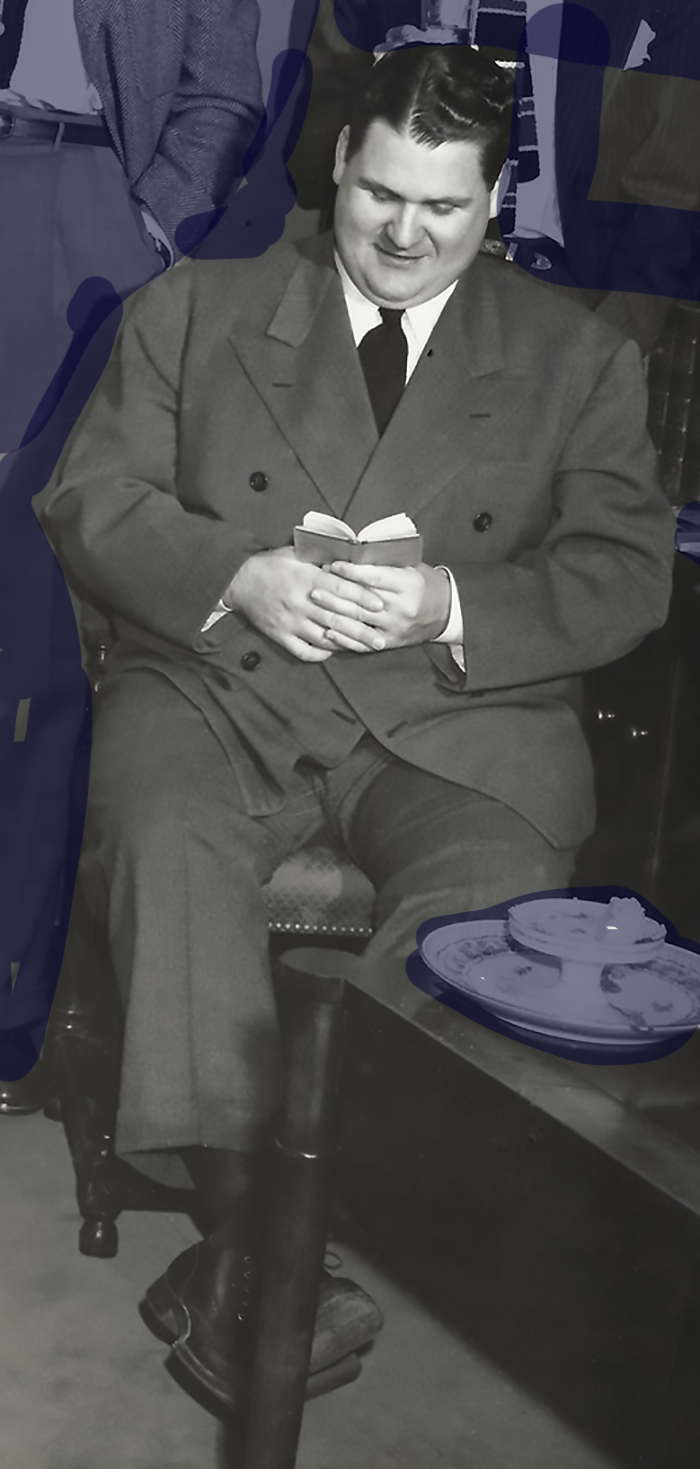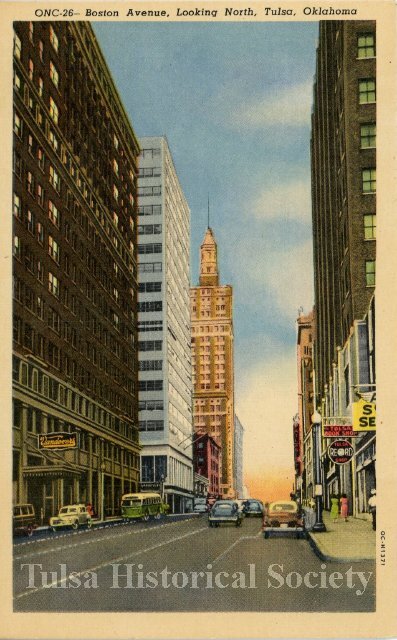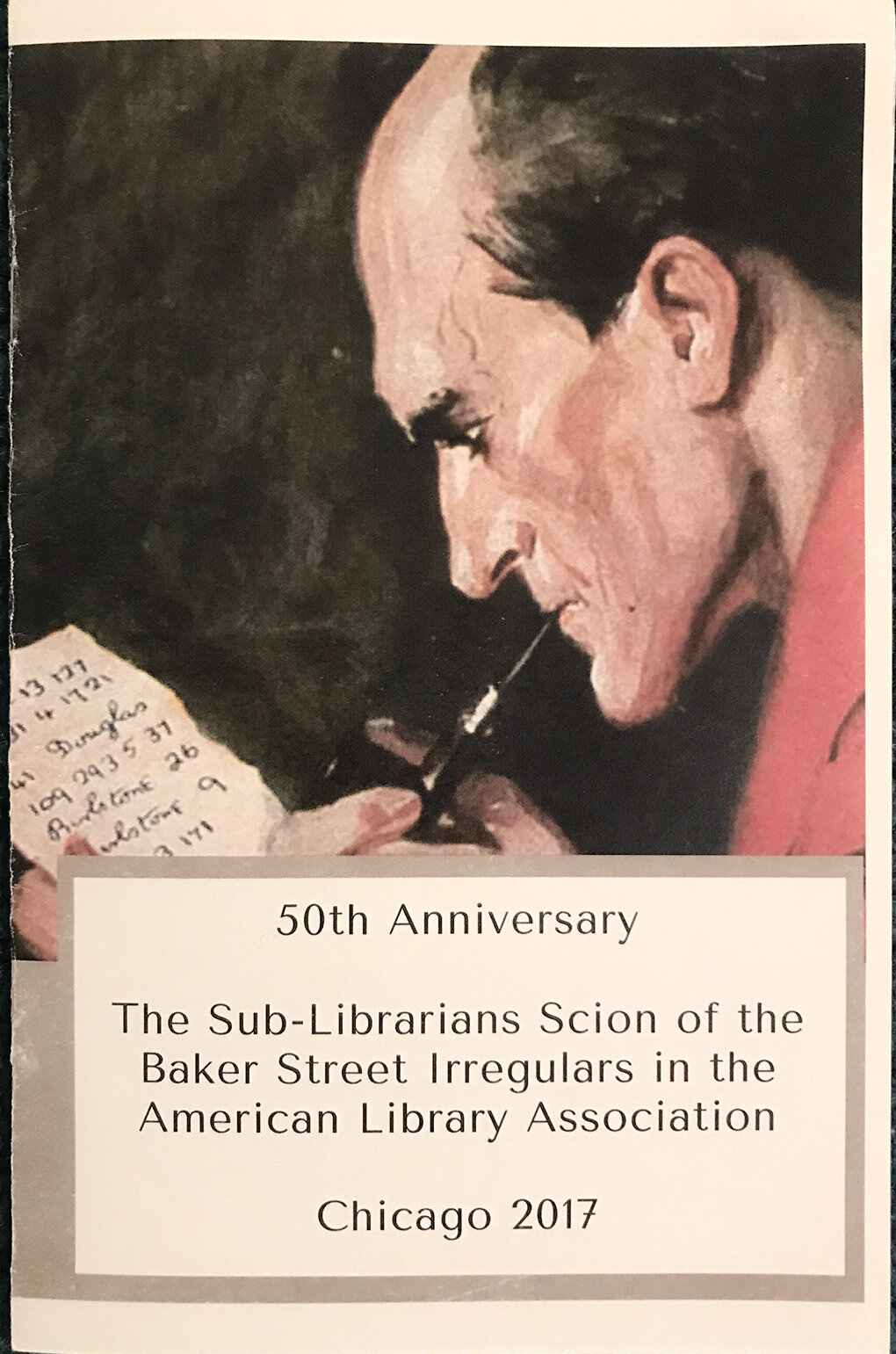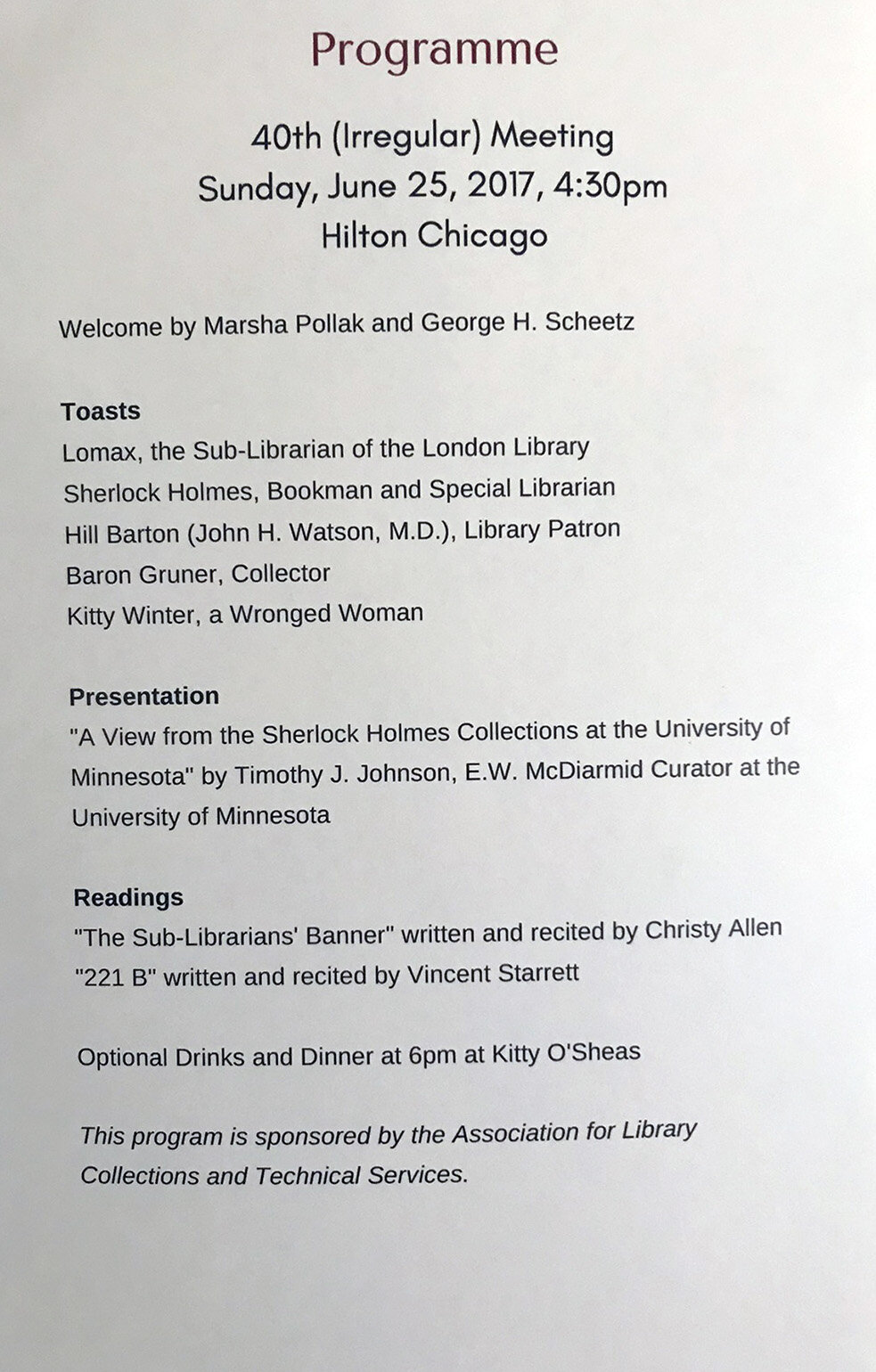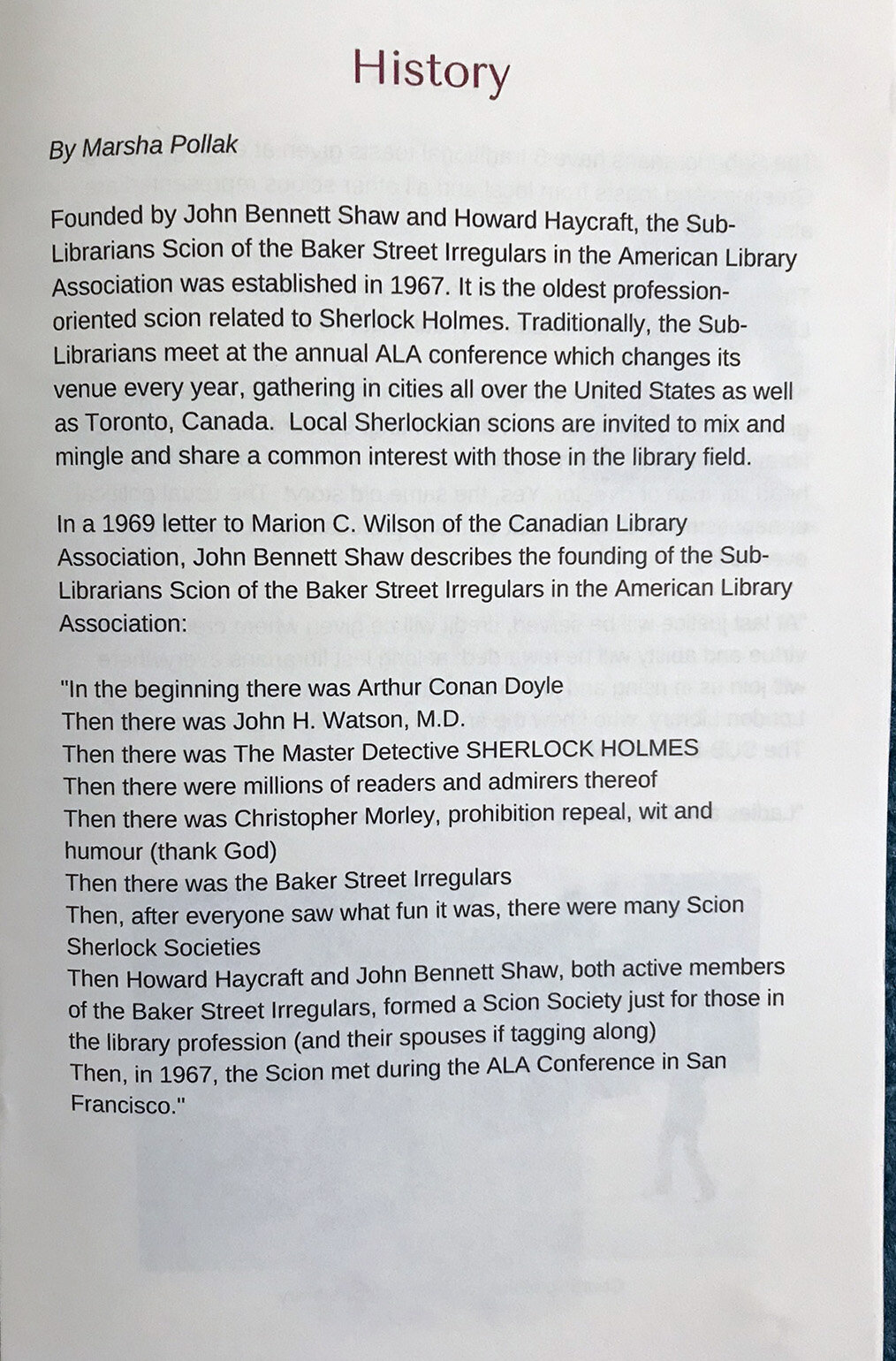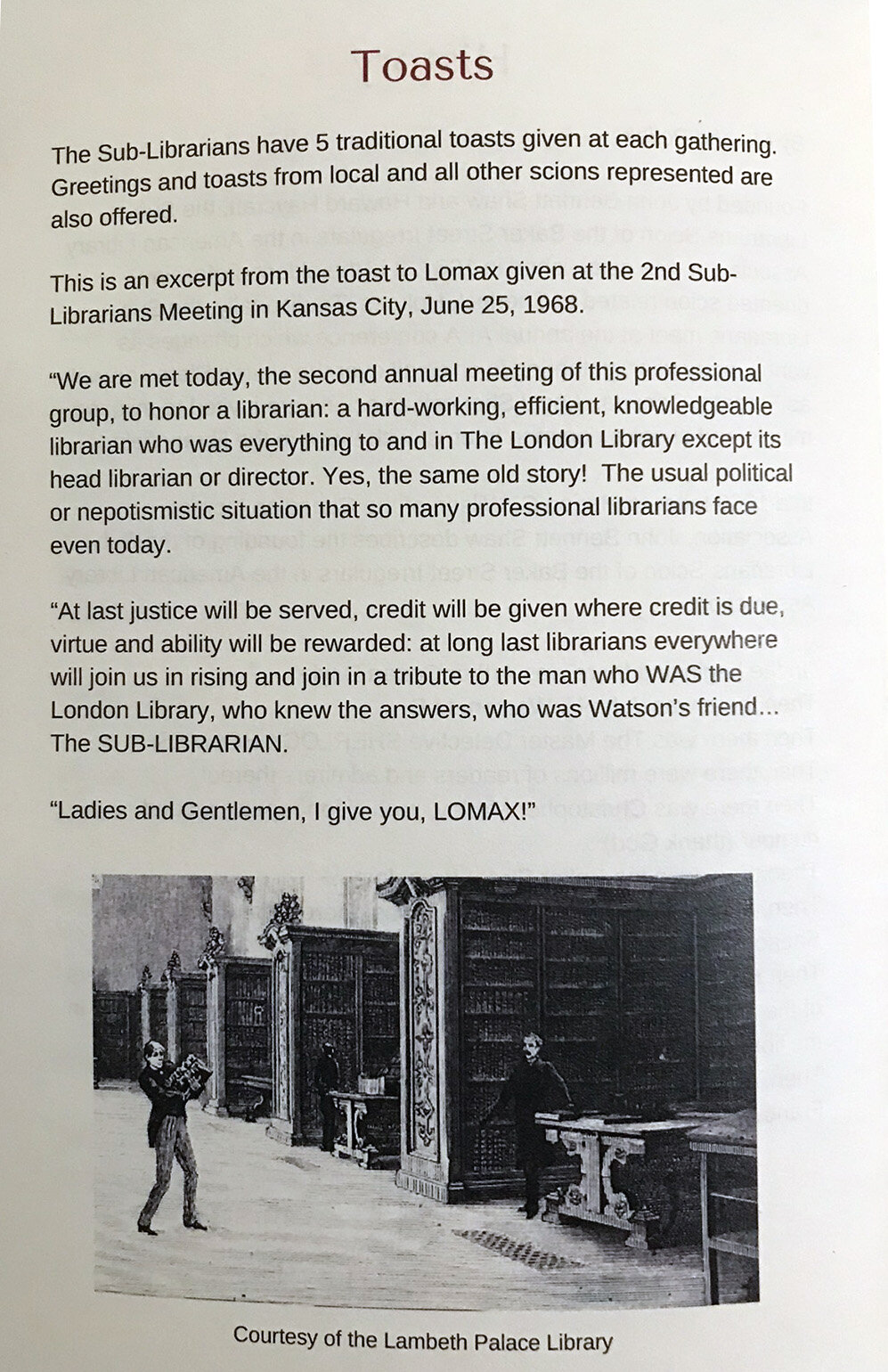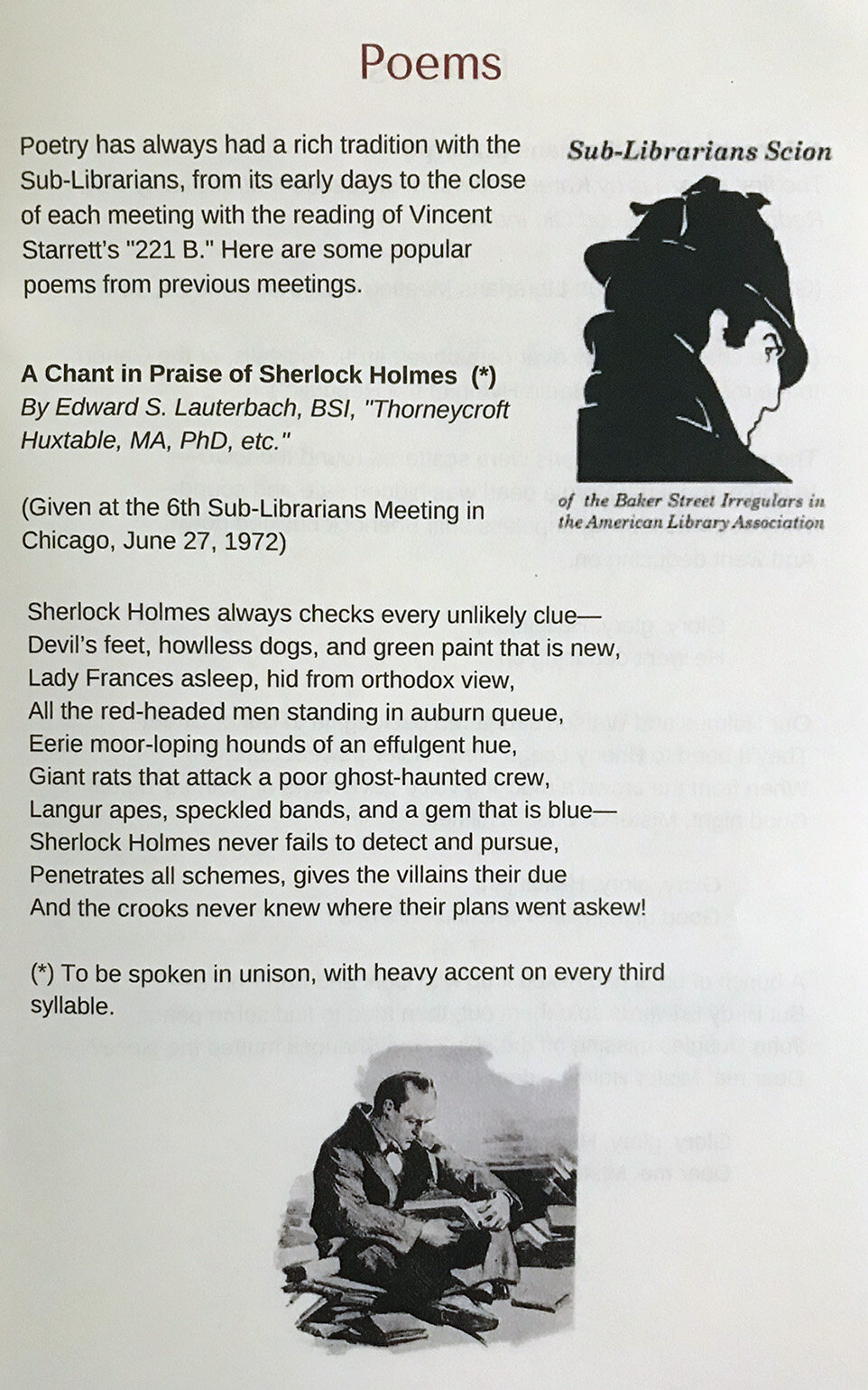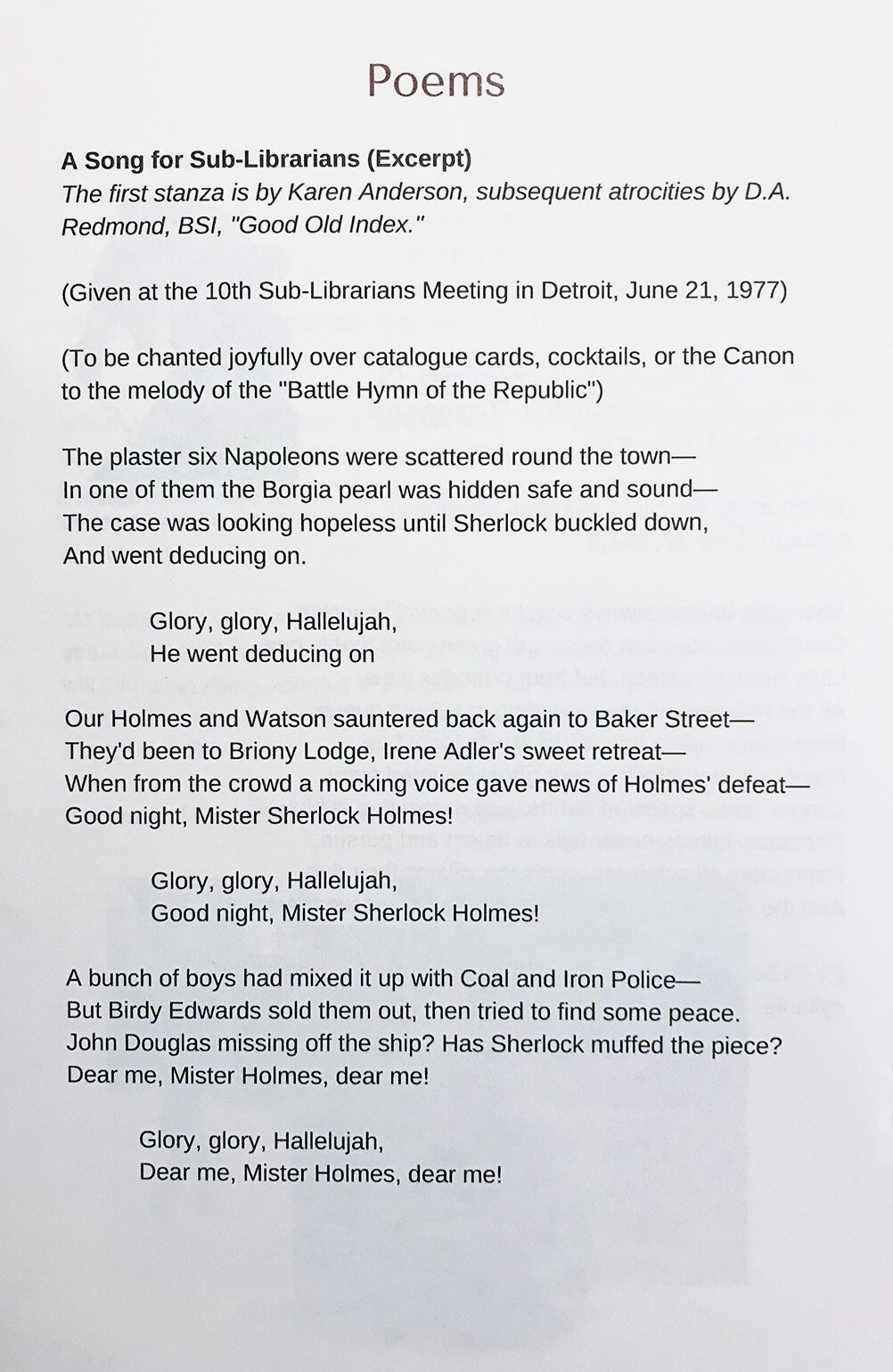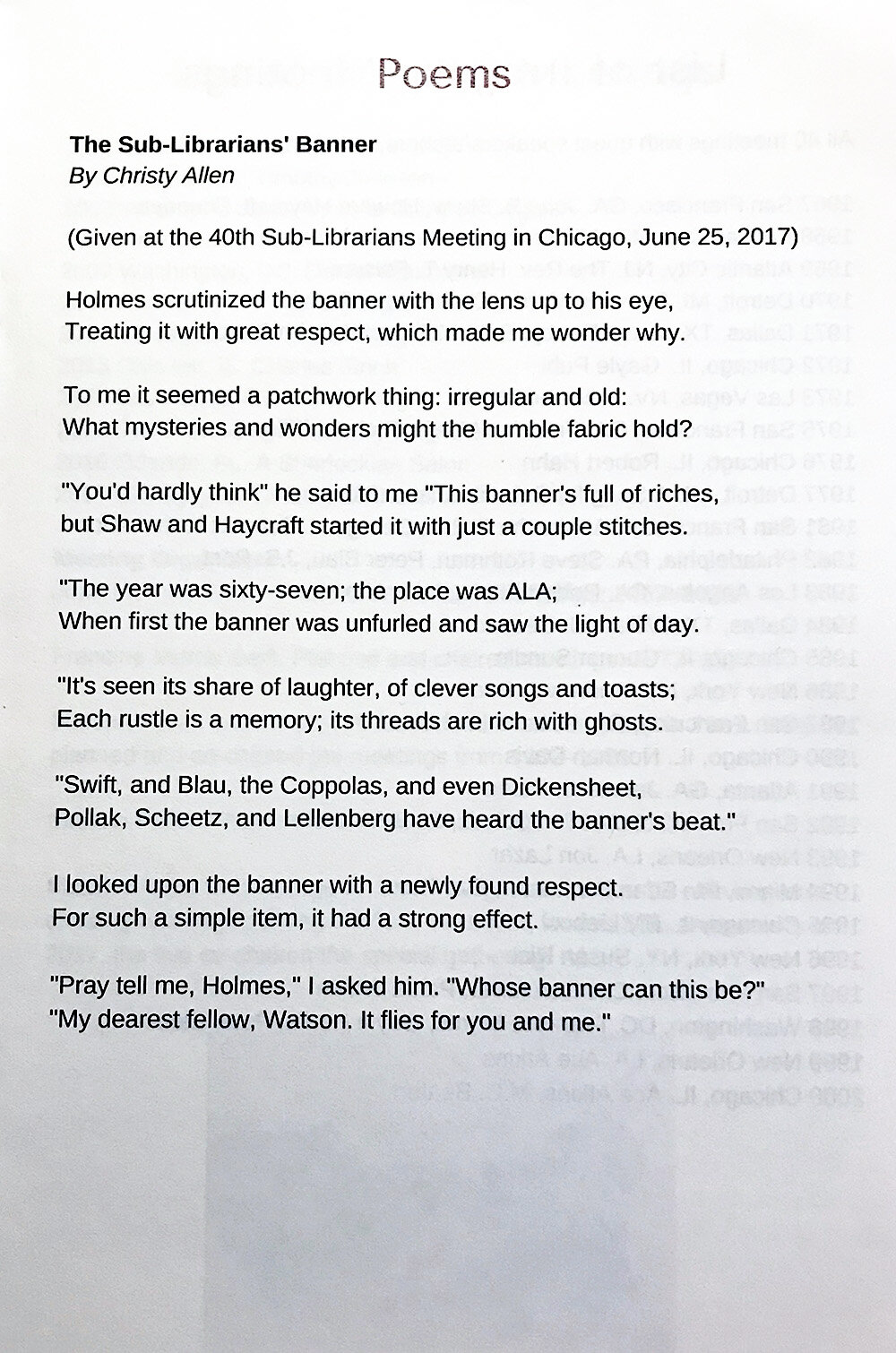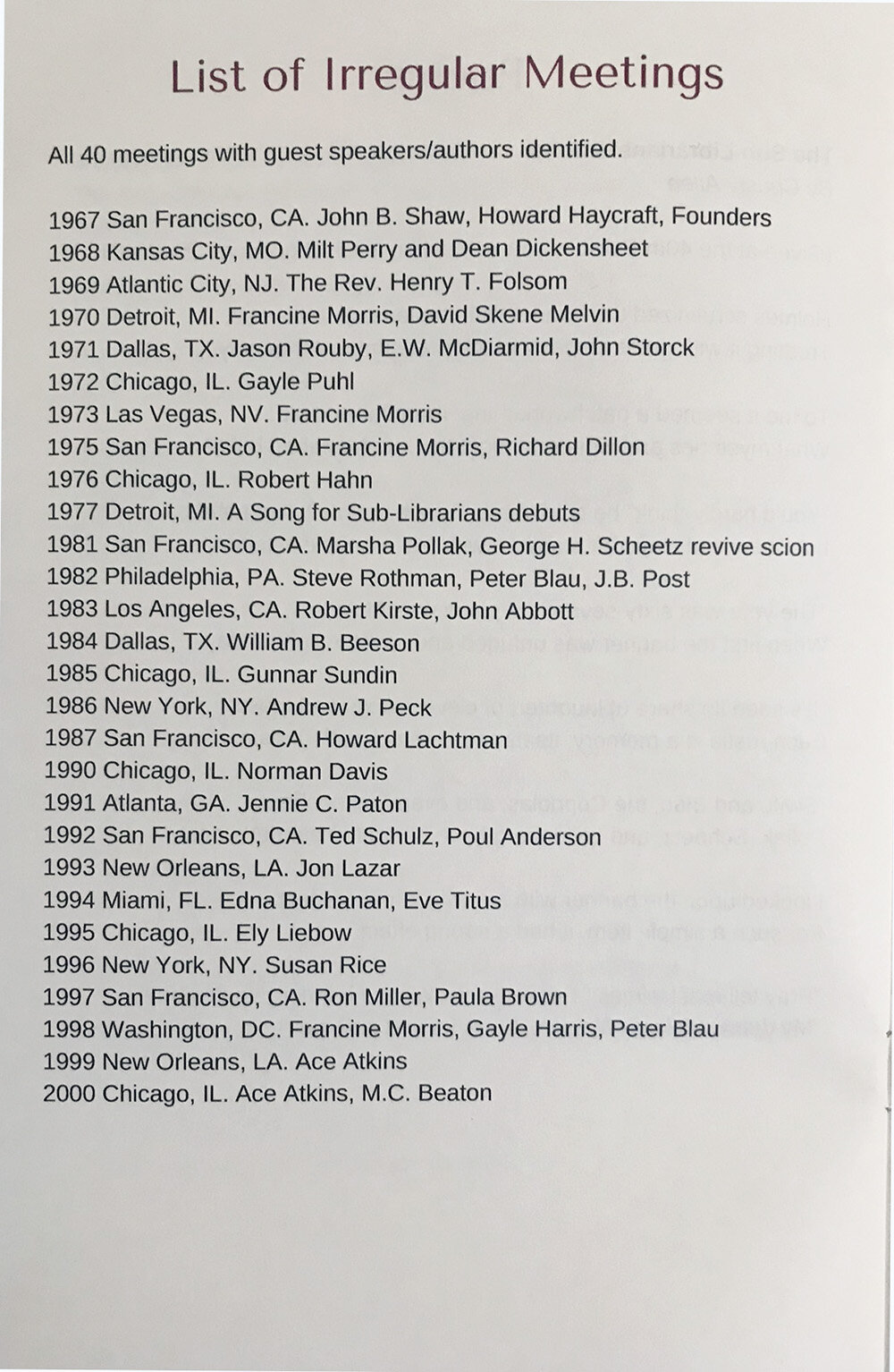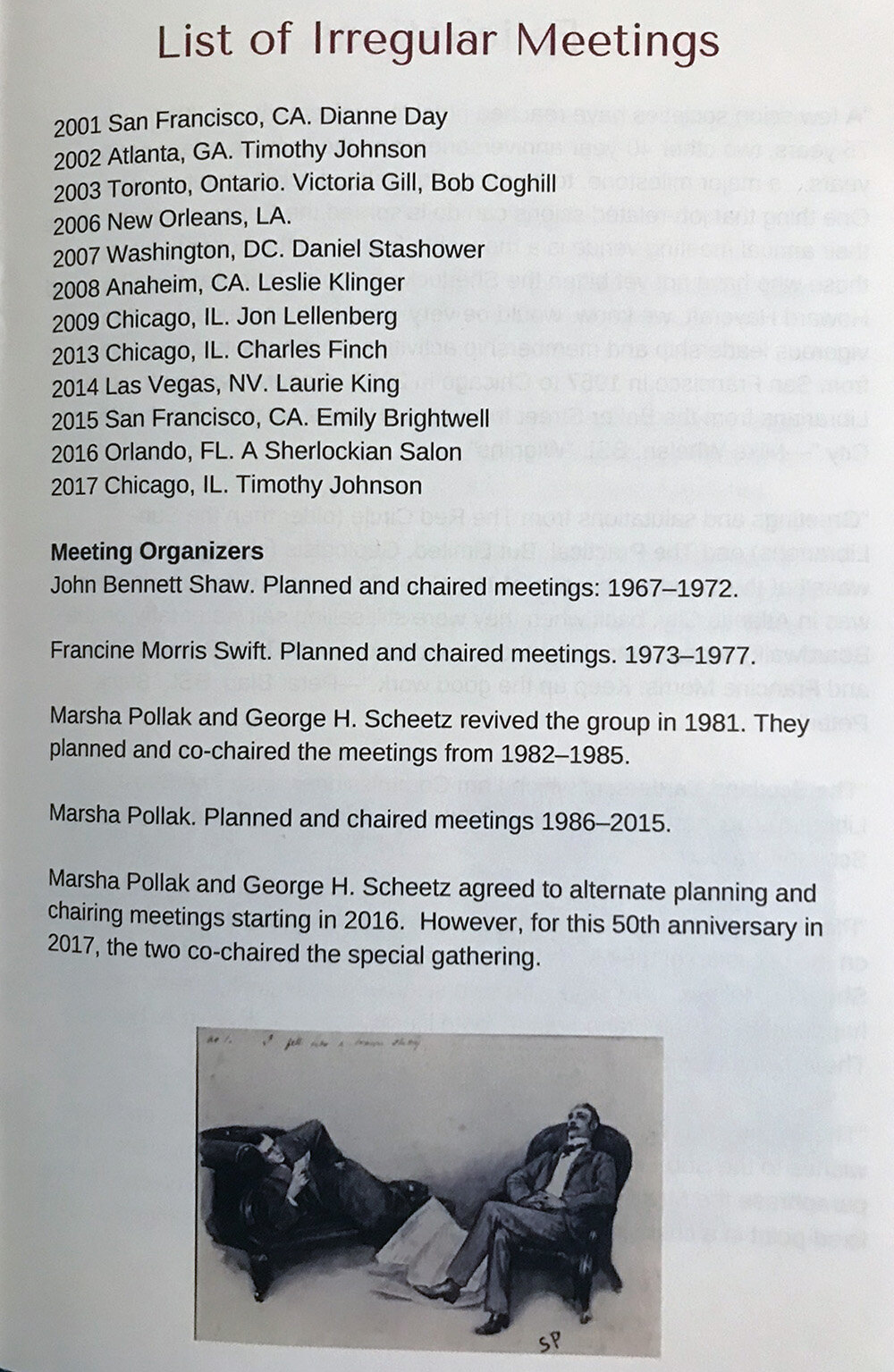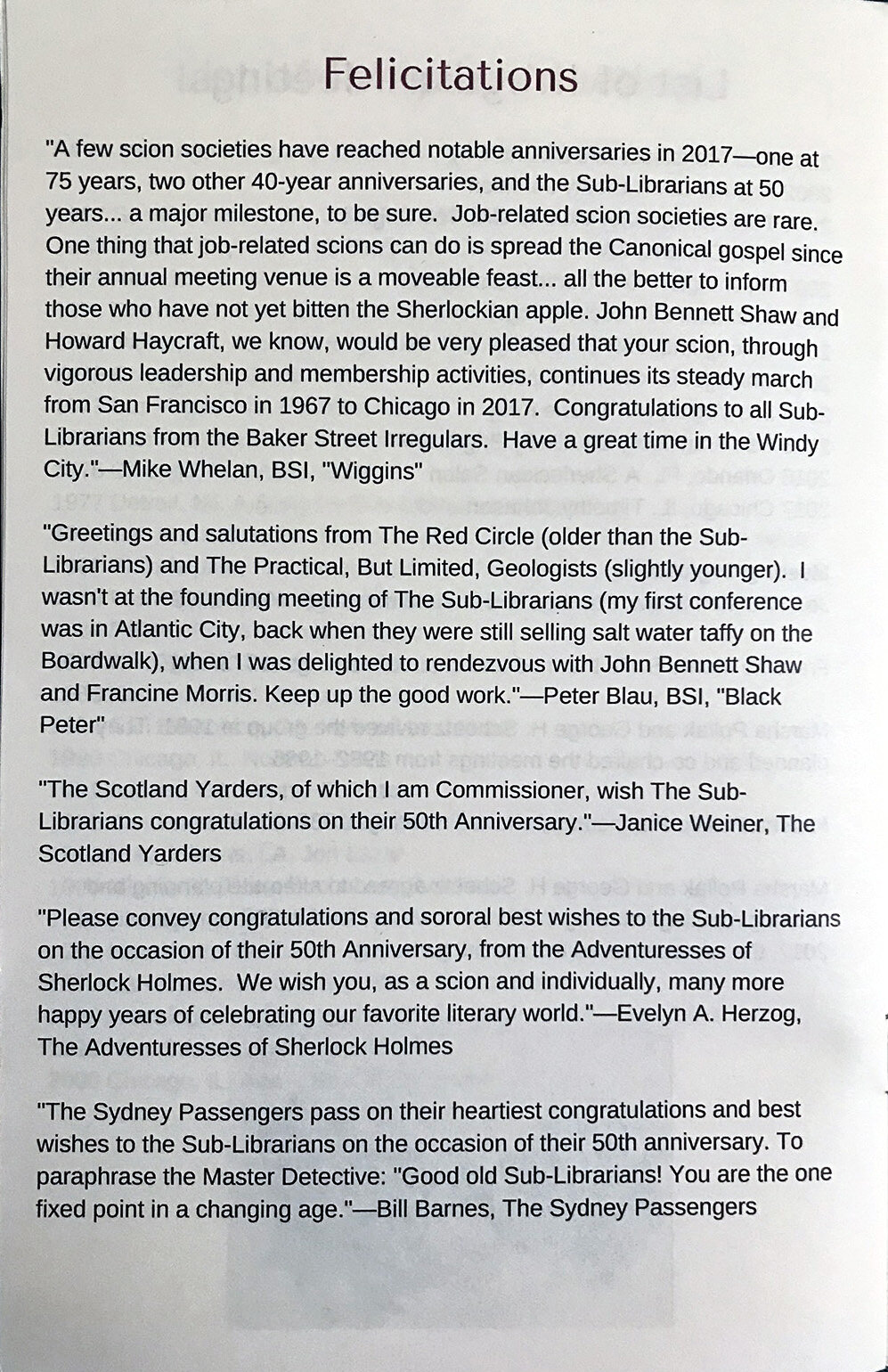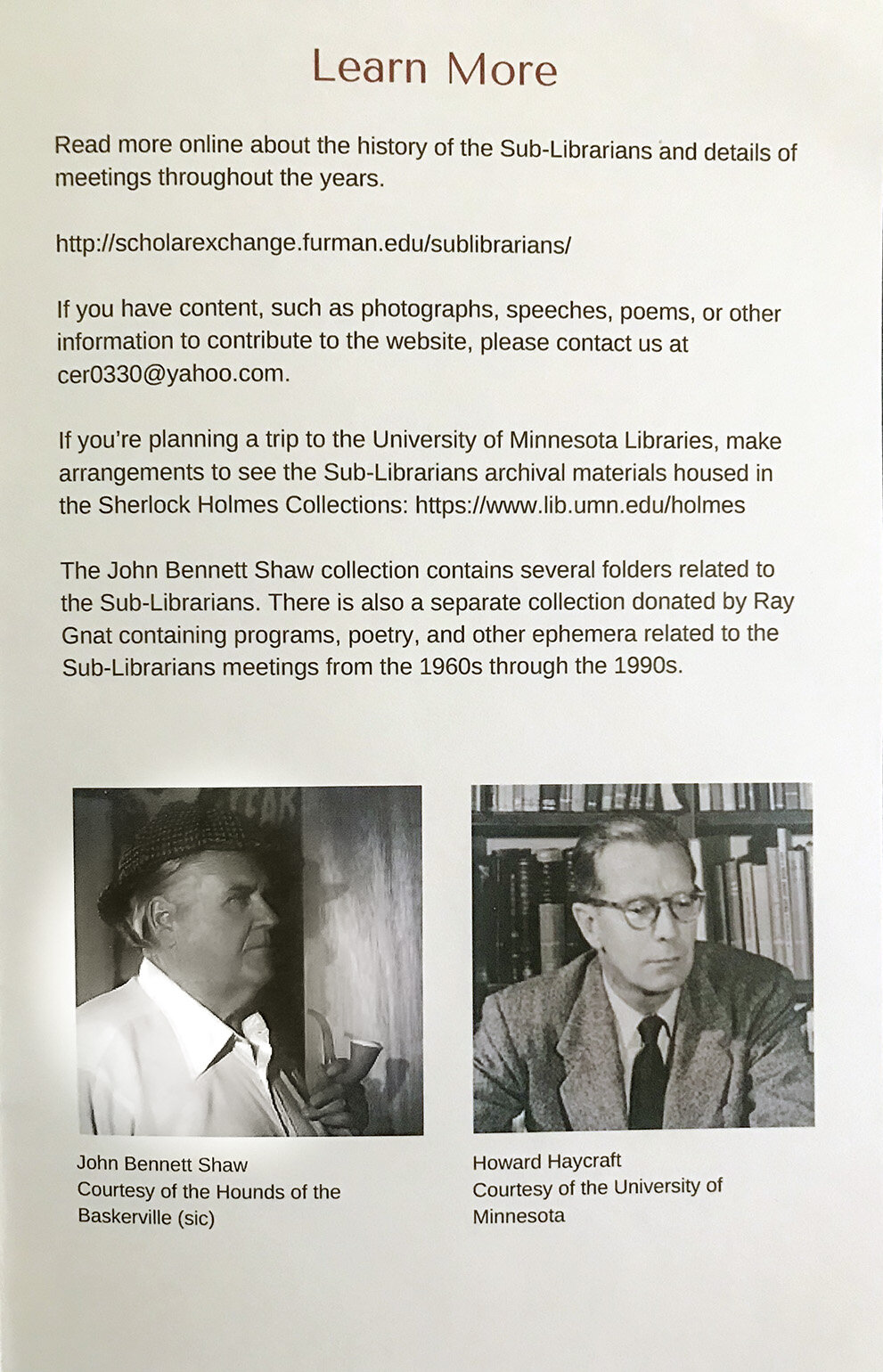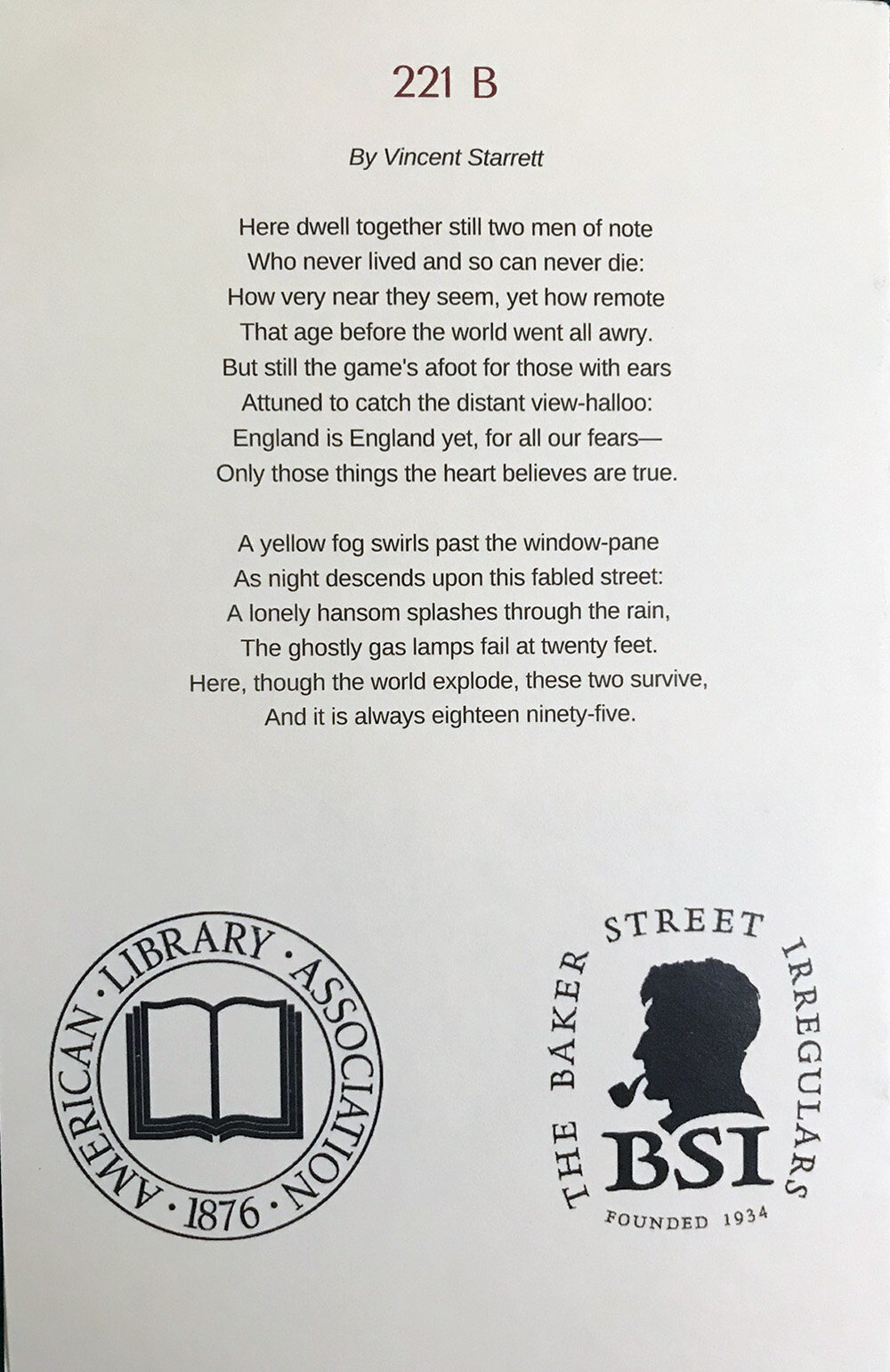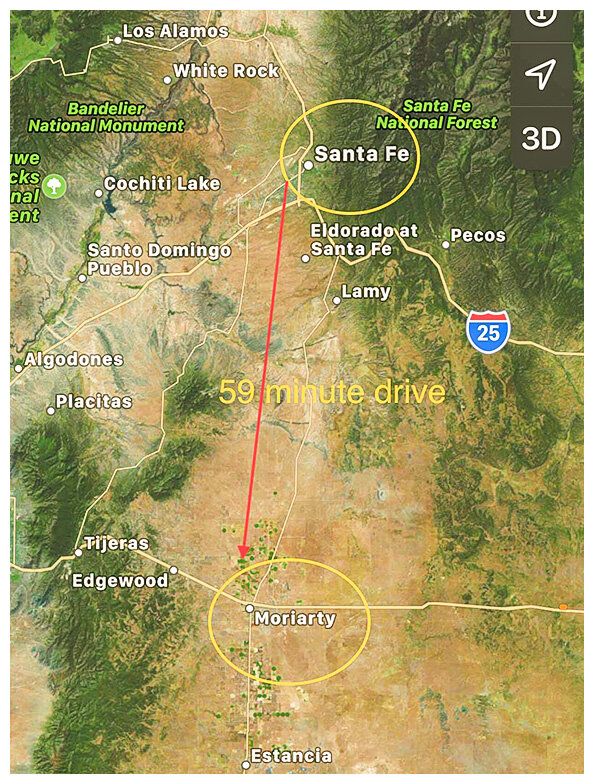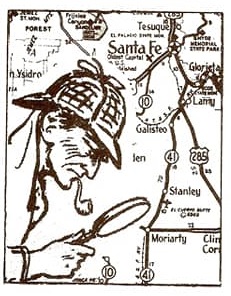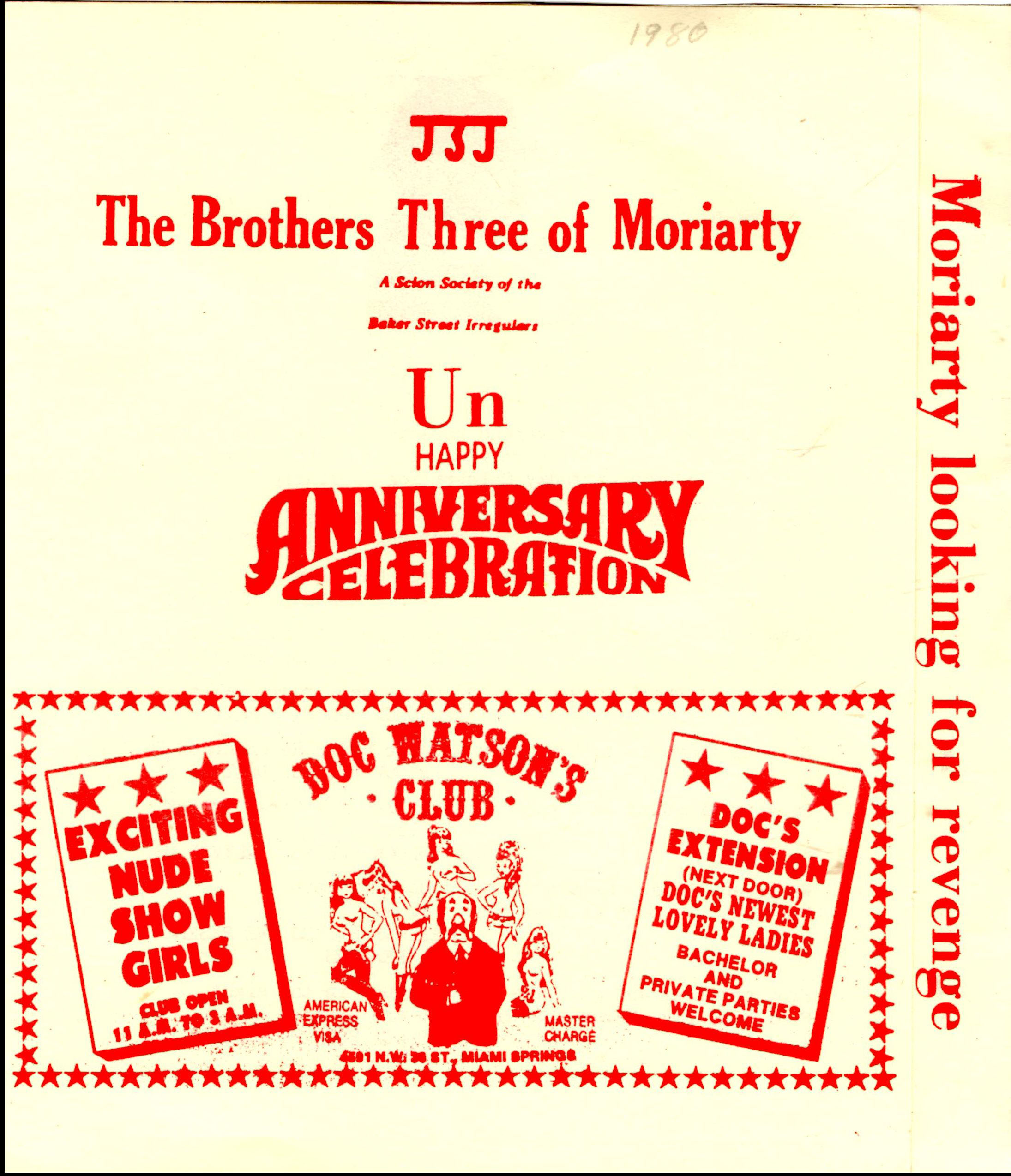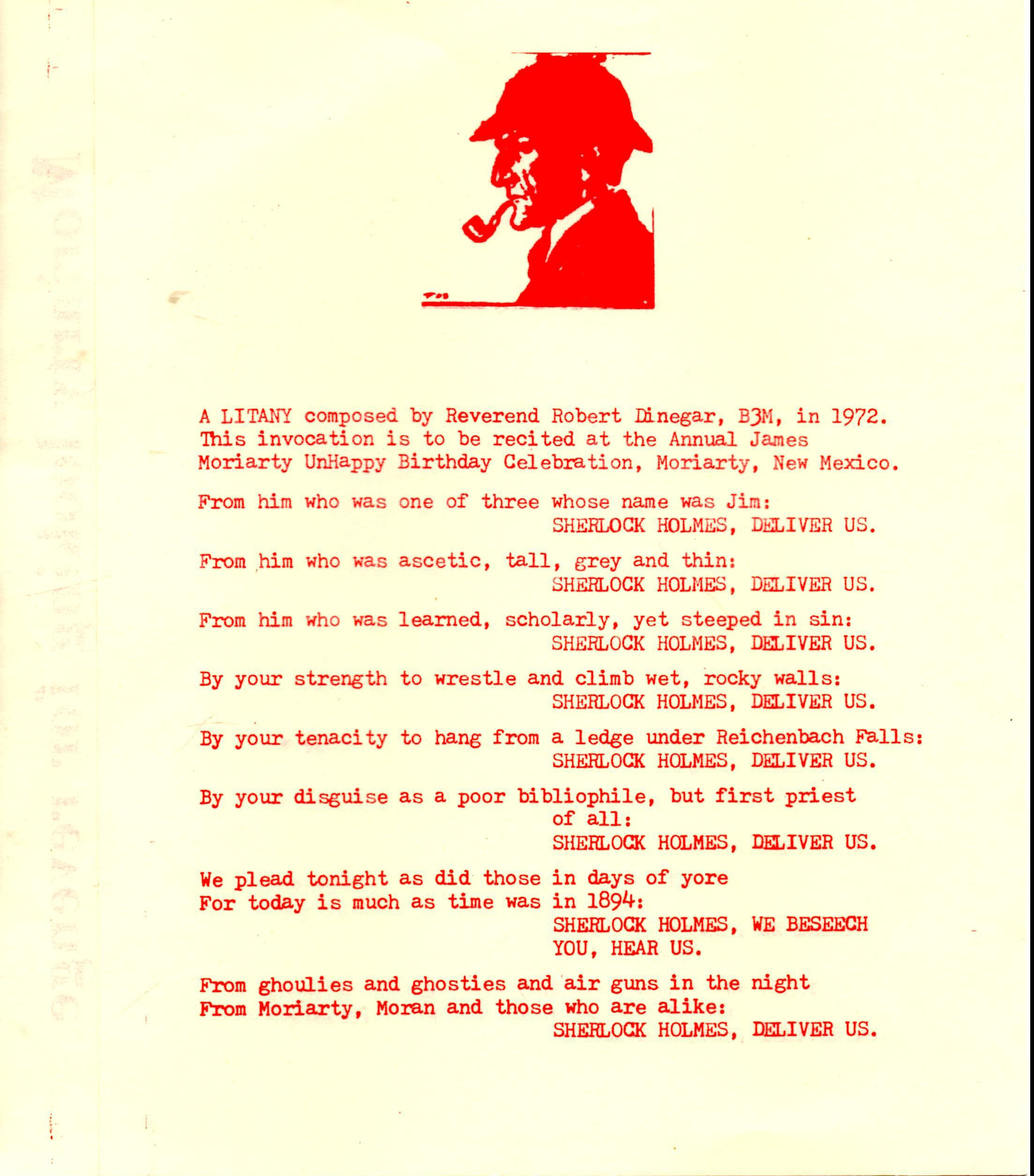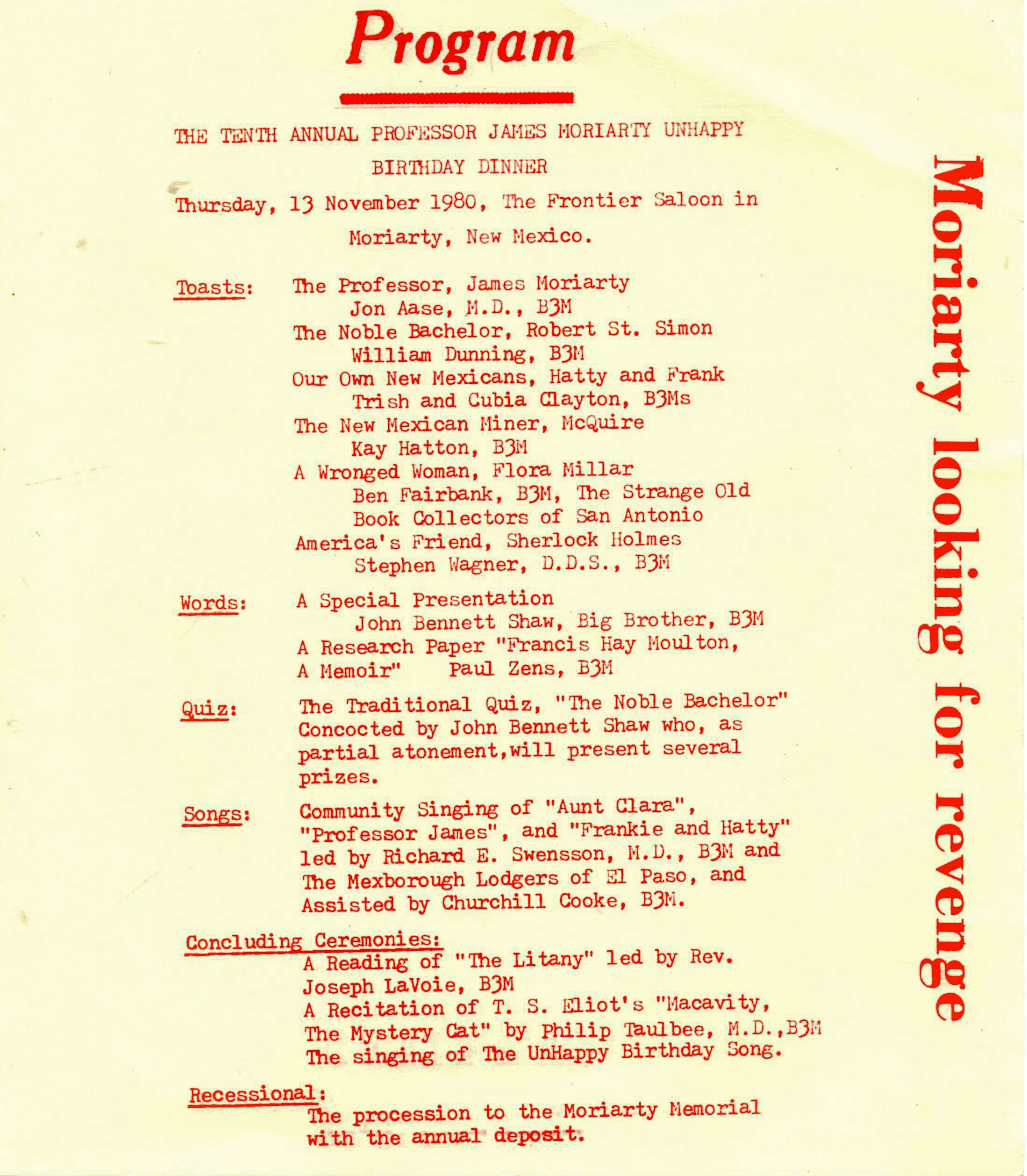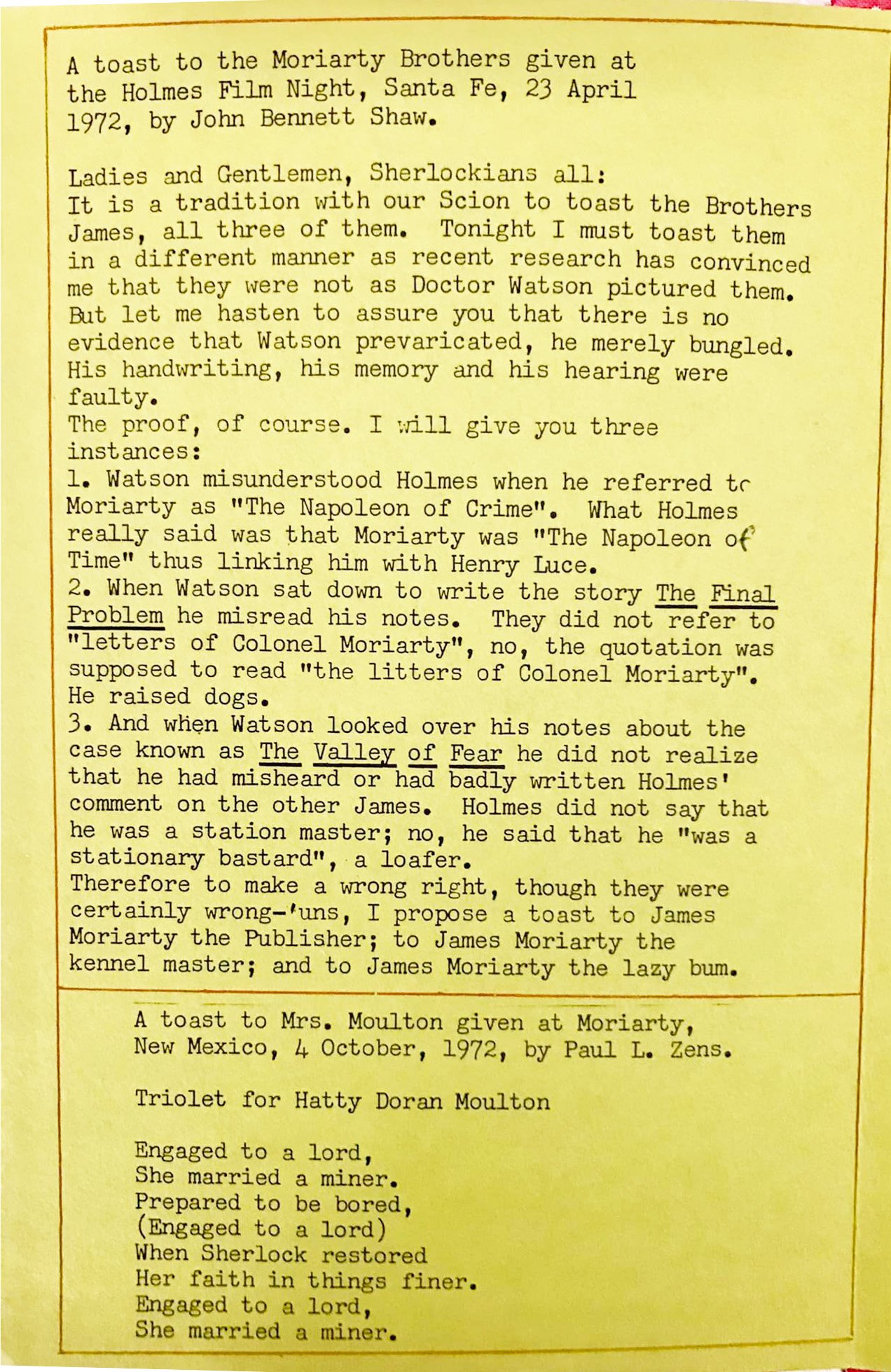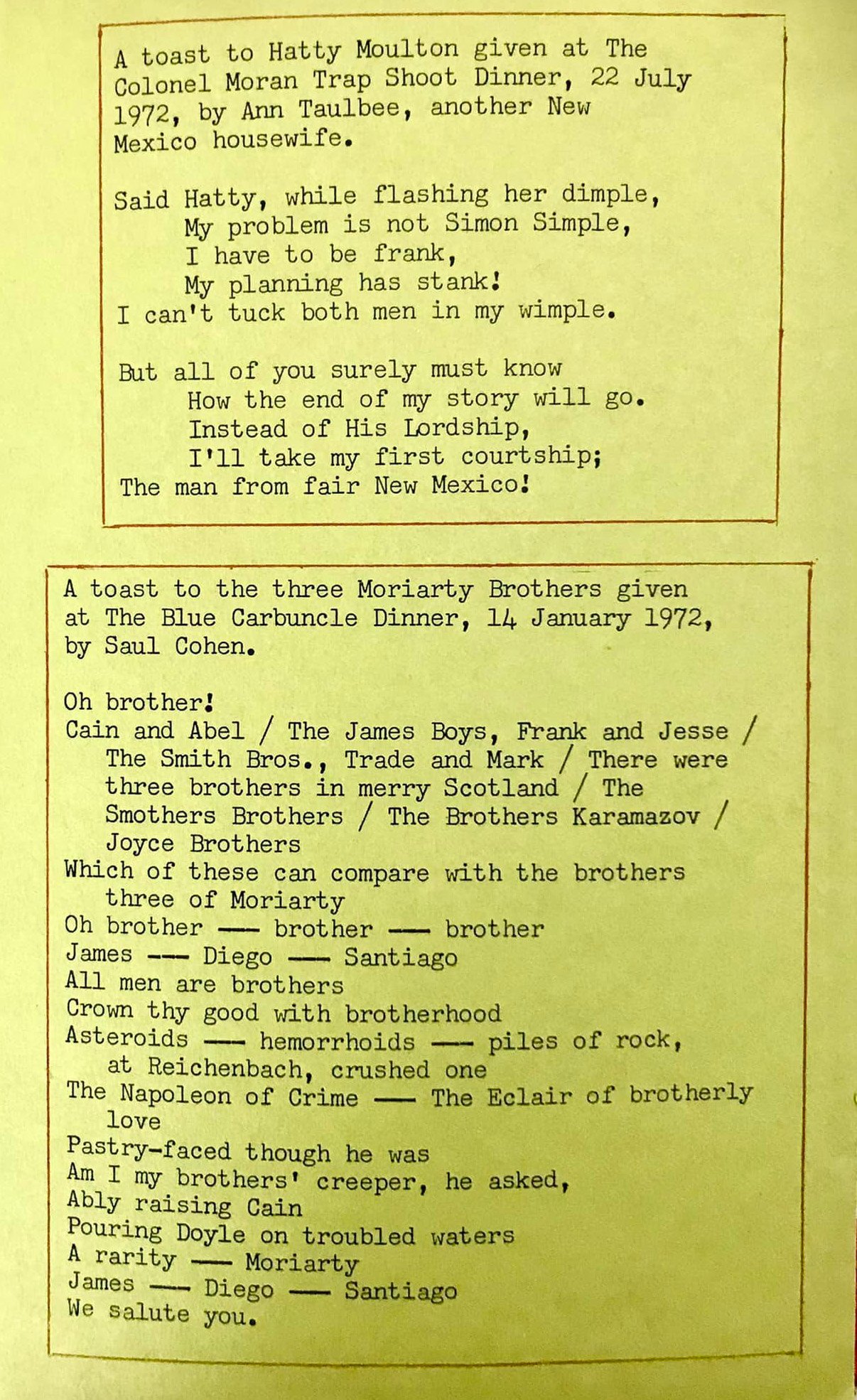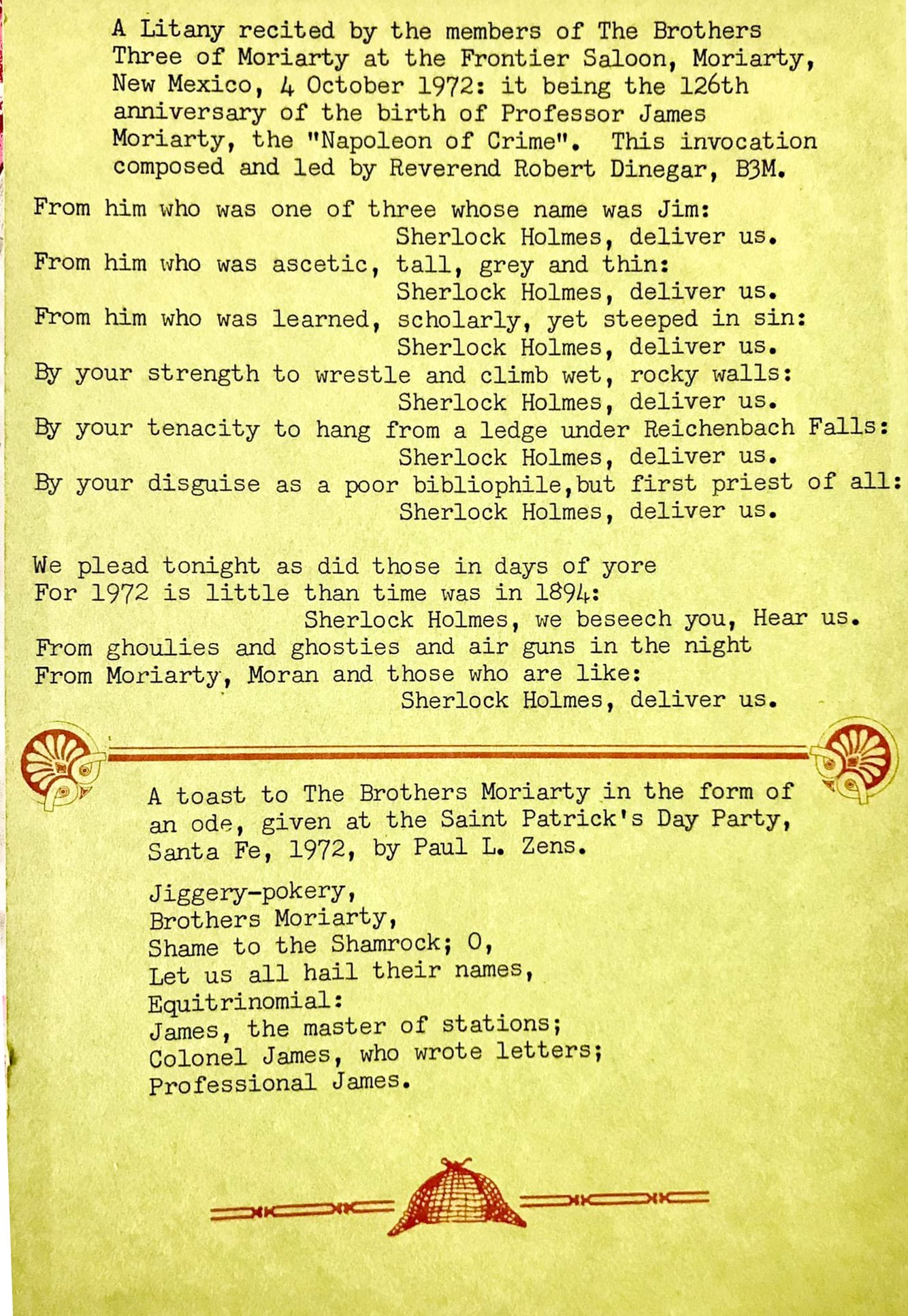John Bennett Shaw
A Personal View
By Jim Hawkins
BSI 2022-The Hans Sloane of My Age
“. . . the man whom above all others I revere.” (THOR)
He was “The Hans Sloane of My Age” BSI-1965, the “Sage of Santa Fe,” the “Johnny Appleseed of Sherlockian Scions,” the “Simpson” of the Baker Street Irregulars, and “Big Brother” in his New Mexico scion society, the Brothers Three of Moriarty. He was also my friend and Sherlockian mentor.
Shaw recommends Hawkins to the Nashville Scholars for membership.
Surely you’ve heard of John Bennett Shaw, the creator of The Shaw 100, the Ragged Shaw quiz book, or the Really Ragged Shaw quiz book. He assisted Ronald De Waal in writing the phenomenal bibliography, The World Bibliography of Sherlock Holmes and Dr. Watson (1974), by making his Sherlockian collection available to him in Tulsa and later in Santa Fe. In 1994, Shaw wrote the introduction for De Waal’s multivolume bibliography, The Universal Sherlock Holmes. Unfortunately, John died just before the bibliography was published.
Shaw took his Sherlock Holmes Symposiums on tour from 1977 to 1993, conducting twenty or so in all, most often on college campuses. The first one was at Notre Dame in 1977. It’s quite possible that you attended one or more of those seminars or were a presenter at one, personally invited by Shaw to share your Sherlockian expertise. Perhaps you were fortunate enough to have known him as a friend in the Baker Street Irregulars or corresponded with him, receiving his famously typed, or mistyped, letters. Whatever the circumstance that brought you to Shaw, you knew you were in the presence of an extraordinary individual.
There is a reason for all of this: Shaw was unique in the annals of Sherlockian lore in the United States and around the world. And no one had more fun with Holmes. Our lives crossed paths during the years 1986 to 1994, and he influenced me in a way I could not have imagined.
You will discover all this and more as you dive into this website,
a labor of love provided by The Friends of John Bennett Shaw and
Jim Hawkins (BSI, 2022 — The Hans Sloane of My Age).
The Baker Street Journal Christmas Annual for 2023 features stories from members of the Shaw family and associates who worked with him in various settings.
The essayists include
Ray Betzner
Peter Blau
Catherine Cooke
Jeff Decker
Steven Doyle
Evelyn Herzog
Tim Johnson
Georgia Shaw
Patrick Shaw
The publication’s editor is Jim Hawkins.
The Baker Street Journal editor
is Dan Andriacco.
(Information posted on November 29, 2023)
This is my tribute to John Bennett Shaw's extraordinary life, including personal recollections, programs, photos, and videos shared by John’s family, the Sherlock Holmes Collections in Minneapolis, and the host of friends who knew and loved him. The twenty or so Shaw Sherlockian Symposiums he conducted across the US are only briefly mentioned but will be explored further in a separate video presentation now in production.
The video is best-viewed full-screen on a desktop computer. Enjoy this labor of love. (Jim Hawkins)
This video tracks John’s life from when he was ten years old in Tulsa, OK, to his death at the age of 80 in Santa Fe in 1994. It focuses on the Sherlockian scion society he began and developed in Santa Fe, his unrivaled library, and his collection of everything Holmesian. The video was created for the 50th Anniversary of the Sherlock Holmes Collections at the Andersen Library in Minneapolis in 2024.
Who was Hans Sloane?
What is his connection to John Bennett Shaw?
by Stephen Slaughter oil on canvas, 1736 (NPG 569)
© National Portrait Gallery, London
Sir Hans Sloane, an Irish physician (1660-1753), was an important figure in British history. In addition to being a physician, he was a naturalist, botanist, and collector (and like John Shaw, he collected everything imaginable).
In his professional life, Sir Hans became President of the Royal College of Physicians in 1719. Eight years later, in 1727, he succeeded Sir Isaac Newton as President of the Royal Society. Sloane became the pre-eminent collector of his time—the 18th Century in England, and, near the end of his life, sold his collection of 71,000 items to the British government. Although his collections were estimated to be worth at least eighty thousand British pounds [many scholars put the figure at £500,000], Sloane settled for £20,000 and the promise that his collections would be saved for future generations. Those collections were held as the beginnings of the British Museum, the British Library, and the Natural History Museum.
Visit the Hans Sloane page on the British Museum website.
When Shaw was made a member of the Baker Street Irregulars in 1965, Julian Wolff gave him the name of Sir Hans Sloane, referenced in the canonical story, The Three Garridebs. In the story, Nathan Garrideb is tricked into believing he will soon receive five million pounds just for being a Garrideb. His ambition is to share science with the world, and with this unexpected money, he believes he could become “the Hans Sloane of my age.” What a perfect nom for John Shaw—The Hans Sloane of My Age.
John once wrote an article for Roger Johnson, editor of the District Messenger, the newsletter of the Sherlock Holmes Society of London, for thirty years or so, explaining what it meant to be “The Hans Sloane of My Age.”
The Significance of Hans Sloane
by John Bennett Shaw
Recently I was pleased to receive a telephone call from Roger Johnson, who was visiting in the United States. He and I have been friends and have associated in various Holmesian matters for many years. However, he made a curious and baffling request: he asked me to write a piece about Hans Sloane.
This left me surprised and confused, for I am Hans Sloane and have been for almost thirty years!
I know this because Dr. Julian Wolff, as Commissionaire of the Baker Street Irregulars, gave me the investiture of “The Hans Sloane of My Age.” Surely Roger did not wish me, at my advanced and decrepit age, to write an autobiography?
However, after calm and rational thought, I deduced that Dr. Wolff, a noted scholar and medical person, and a most valued friend, must have invested me with the name or description of a character who was mentioned in the Sherlock Holmes Canon—certainly in one of the sixty cases. I proceeded with more research and found that Dr. Sloane was indeed mentioned in “The Adventure of the Three Garridebs”—and that he was a real person, not a creation of the great Dr. Doyle. And after reading about him, I concluded that bearing his name was a distinct honor.
This is the gist of what I read. Sir Hans Sloane (1660-1753) was a noted British physician. He was born in North Ireland, educated in the United Kingdom and in France, and successfully practiced medicine in England and Jamaica. In a career in which he received many honors, he was elected to succeed Sir Isaac Newton as the Presidential chair of the Royal Society and was editor of The Philosophical Transactions for twenty years. In 1716 he was created a baronet, and in 1719 he became President of the College of Physicians. Yet with all this and much more, his greatest fame came as a collector of plants and of the printed word. On his death, his collections were bequeathed to the state, and in 1759, they opened to the public as The British Museum.
After reading this and more, I understood that the appellation given to me as a member of the Baker Street Irregulars as a great compliment. To be dubbed “The Hans Sloane of My Age” by Dr. Julian Wolff was both flattering and challenging.
In the story, it was old Nathan Garrideb who remarked that if he received a third part of the Garrideb estate, he would become “the Hans Sloane of my age”-- for he was a collector also. Obviously, Dr. Julian Wolff, who knew the Canon as few ever did, knew as well that Sloane was a consummate collector and that I aspired to be such as a Sherlockian. I wear the name of Hans Sloane with great pride, having read about him and having known Julian.
(See this Timeline for the creation of this website. It will detail my journey with John Bennett Shaw from the first time I saw his name in Baring-Gould’s Annotated Sherlock Holmes to the day I received my Brothers Three of Moriarty scion pin from John’s friend, Saul Cohen.)
Shaw had this to say about himself: I am interested in Sherlock Holmes, Sir Arthur Conan Doyle, and the world in which they live. So what do I do? I obtain as many books, pamphlets, periodicals, Holmes Society publications, video and audio tapes, and other materials such as statues, puzzles, plaques, T-shirts, mugs, and even a Professor Moriarty toilet seat as I can. (From his Foreword to The Universal Sherlock Holmes.)
Mattias Boström, winner of the Agatha Award for best nonfiction in 2018, assessed the importance of John Shaw in these words: “For a whole generation of Sherlockians, no one was as important as Shaw. . .If it was possible that one person could make the worldwide interest in Sherlock Holmes continue as well as grow, that person was John Bennett Shaw.” (From Holmes to Sherlock, [2013; English version, translated by Michael Gallagher, New York: The Mysterious Press, 2017])
John Shaw at the age of 10 or 11. (Click on image to enlarge.)
By the age of 10, John Shaw was already collecting books, especially the Sherlock Holmes stories by Sir Arthur Conan Doyle. Quoting Shaw, “When I was eight or nine, I had an uncle who wanted to encourage me to read, so he set up a charge account at a store in Tulsa. You could get a hardback book for fifty cents then. The first Holmes story I read was The Hound of the Baskervilles, and that was the beginning. After a while, I decided to collect Holmes.”
Poster for the October 1995 dedication of the John Shaw Collection
During his life, he amassed an incredible collection of Sherlockiana and squeezed it into every nook and cranny in his adobe home at 1917 Fort Union Drive, Santa Fe, New Mexico. When the time was right, he made financial arrangements with the University of Minnesota Libraries to catalog and house his entire stash. “They will get my books over my dead body“ was a phrase he shared with visitors.
In October 1995, one year after Shaw’s death, his library was dedicated as the John Bennett Shaw Collection at the University of Minnesota. It contained some 12,000 books, 3,500 periodicals, 30,000 clippings in alphabetically arranged notebooks, and a vast amount of other Sherlockian ephemera. Shaw boasted that when all the books were boxed and ready to ship, “the number of boxes came to 221,” an observation unique to his way of thinking.
Harris & Ewing. Hench, Philip Showalter. 1949. University of Minnesota Libraries, University Archives., umedia.lib.umn.edu/item/p16022coll175:12987
The Sherlock Holmes Collections
In a period of just over ten years the Wilson Library at the University of Minnesota had become the repository of several valuable Sherlock Holmes collections. As early as 1974 the University purchased the James C. Iraldi library consisting of 160 books, 150 periodicals, and much ephemera, especially strong in British and American first editions of the Canon.
Three years later the magnificent library of Philip S. Hench was acquired and included 1,750 books, 1,400 periodicals, and almost unbelievably, four copies of Beeton’s Christmas Annual of 1887, featuring A Study in Scarlet, the short story in which Sherlock Holmes was introduced to the world. Since then, other complete libraries and smaller collections have been added, now known as the Sherlock Holmes Collections. This link to the first newsletter tells the complete story. [Bruce E. Southworth, Editor. The Friends of the Sherlock Holmes Collections, Volume 1, Number 1. (University of Minnesota Library - March 1997)]
The Sherlock Holmes Collections at the University of Minnesota Libraries constitute the world’s largest gathering of material related to Sherlock Holmes and his creator Sir Arthur Conan Doyle. The Collections consist of over 60,000 items including books, journals, and a wide variety of other forms through which the transformation of the Holmes character from the printed page to a cultural icon can be traced. (from the UMN Library website: Browse the Collections)
John Shaw’s library, an 18-square-foot room, totally encompassed with bookshelves filled with books, statues, posters, pipes, and file boxes.
But John Bennett Shaw was much more than a collector of “all things Holmesian,” as he was fond of saying. He was also a mentor to individuals interested in Holmes and wishing to start a local Sherlock Holmes chapter (or scion society); he was a great humorist with a quick and devilish wit; and he was a friend to Sherlockians around the world, many of whom were members of the Baker Street Irregulars founded by Christopher Morley in 1934, the world’s first literary and scholarly society devoted to the writings of Sir Arthur Conan Doyle and the systematic study of Sherlock Holmes.
The B.S.I. was the first Sherlock Holmes society.
Although Shaw was born in Tulsa and lived there until his middle 50’s, he was in no way provincial. Through his involvement with the Baker Street Irregulars his reach was global. He was given his BSI investiture “The Hans Sloane of My Age” in 1965, joining the colorful cast of characters who met every January in New York City for the BSI Dinner, held as close as possible to the traditional birth date of Sherlock Holmes, January 6 (1854). Shaw served the Baker Street Irregulars as “Simpson”, the official greeter and encourager for the organization. In that role he assisted many groups of Holmes fans and helped them begin or enrich their scion society.
During his Tulsa days, Shaw dressed like all businessmen, in suits and ties, but soon after moving to Santa Fe he adopted the Southwest dress code—relaxed, with a turquoise and silver belt buckle and bolo lanyard-like necktie.
A distance of 640 miles separates the cities of Tulsa and Santa Fe, but in reality, they are worlds apart. In these disparate cultures, Shaw’s reputation was forged and refined. Incorporated in 1898, just fifteen years before John was born, Tulsa was a booming oil town. Santa Fe, founded in 1610 and the oldest European community west of the Mississippi, had been a gathering place for native tribes for hundreds of years and European seekers since the 17th century. Citizen Shaw made lasting contributions to both cities.
My apologies for interjecting this bit of information,
but it is apropos to the continuation of John’s story,
and this is the place to share it.
On the night of January 14, 2022 the author of this website attended his first Baker Street Irregulars Dinner, held at the Yale Club in the heart of New York City. It was a most significant night! After two years of virtual meetings due to the COVID pandemic, 131 Sherlockians gathered in person for the invitation-only BSI dinner hosted by Michael Kean, “Wiggins” of the BSI. Fourteen excited Sherlockians, including Tim Johnson and Jim Hawkins, were awarded their BSI investitures.
Read more about Tim Johnson here. I mention Tim because he has been the curator of the Sherlock Holmes Collections at the University of Minnesota (Minneapolis) the entire time I was visiting John Shaw in Santa Fe and during the creation of this website.
Without Tim Johnson’s gracious assistance this site would not exist. His investiture is “Theophilus Johnson”; mine is the same that was given to John Bennett Shaw in 1965, “The Hans Sloane of My Age.”
In the Baker Street Irregulars organization one person, and one person only has the power to invite guests, decide who will become a new member of the BSI, and decide what their investiture will be—Wiggins. Michael Kean, “Wiggins,” I am forever in your debt. Thank you, Sir!
BSI Investiture for John Bennett Shaw (1965) and Jim Hawkins (2022)
TULSA
1913 — 1970
Panorama of Tulsa, 1909 (Wikipedia Commons. Jack, Clarence, copyright claimant [Public domain])
YouTube Video of Tulsa, OK (1945——1955)
click to watch the 14-minute video
Published by the Tulsa City Council in 2014 from U. S. government archives, this is a video of the town where John Shaw grew up, and where in 1940 he completed his master’s degree in English literature (University of Tulsa). In his varied careers he “was owner and manager of the Tulsa Book Shop and Tulsa Record Shop, was the managing officer of the Bennett (Oil) Drilling Company, manager of the Fitzgerald Funeral Home, and lay director of the Catholic Center as diocesan director of information in Tulsa.” (Richard “Dick” Conklin, “221B Baker Street,” Notre Dame Magazine, Spring 1990. Permission to quote from that article granted by Kerry Temple, editor.) Download the Conklin article in its entirety, Click Here.
John and Margaret in 1935 in Tulsa.
In 1938 John married Margaret Mary “Gugger” Fitzgerald. Born in Shawnee, OK, in 1914, “the first Mrs. Shaw” went on to receive a degree in petroleum engineering and geology from the University of Tulsa. Members of the Shaw family shared that the nickname, Gugger, came from one of the children who couldn’t pronounce “Mother.” A devoted wife and loving mother, Margaret had flaming red hair for most of her life. Medical struggles with rheumatic heart disease and other complications brought about her untimely death in 1969 at the age of 54.
John Shaw was born in Tulsa, Oklahoma, on October 10, 1913. He was a quick learner and fell in love with books early in life. Encouraged by a generous uncle who funded his hobby, John bought all the books he could afford within his five-dollars-a-month budget. As a devoted Catholic, he came under the influence of G. K. Chesterton, the British author of the Father Brown detective stories. (More on Father Brown here.)
Thus, John’s first book collecting passion was for volumes by Chesterton. He even attended Notre Dame under the impression that the famous author would be on the faculty during his freshman year. He was not, but in 1965, years after Shaw earned his college degree there in 1937 (A.B., cum laude), he graciously donated his entire Chesterton collection (over 2,000 volumes) to the University. He then began collecting Sherlock Holmes in earnest, explaining that “he had the selectivity of a vacuum cleaner.”
SHAW & GARDNER
Tulsa Bibliophiles/8 P.M. April 4, 1950. 2121 E. 29th St. / Photo by Hopkins Photography Co. / L to R Standing: John Ellinghauser, Beirg Soph, Martin Gardner. L to R Seated: Frank Bellingsley, James Gourley, Donald McCormick, George Parks, Jack Houston, John Shaw.
Two annotations of note.
Martin Gardner, a lifelong friend of John Shaw, was born in Tulsa in 1914. A brilliant author and mathematician, Gardner was, for many years, the games editor at Scientific American magazine and editor of numerous editions of The Annotated Alice, the most recent being the 150th Anniversary Edition, published by W. W. Norton & Company, Inc. (2015).
Gardner’s Annotated Alice in Wonderland (1960) was the inspiration for William Baring-Gould’s Annotated Sherlock Holmes, published in 1967.
Following high school days in Tulsa, Shaw attended college at Notre Dame and Gardner matriculated at the University of Chicago in Illinois. Shaw became one of the leading collectors and scholars about the world’s first consulting detective and Gardner became one of the world’s most recognized “puzzle creators and solvers”. (A link to MacTutor, written by by J J O'Connor and E F Robertson for the School of Mathematics and Statistics, University of St. Andrews, Scotland.)
In this story reported by Vincent Starrett in the Chicago Tribune in 1948, Gardner tells of an incident about Shaw - the Bookseller and Bibliophile.
(Story shared by Ray Betzner).
One of the many John Shaw stories shared to the Friends of the Sherlock Holmes Collections Newsletter was written by Martin Gardner. Read Remembering John Bennett Shaw on page 6 of the December, 2009 newsletter, Vol. 13, No. 4. (With permission from the newsletter editors.)
Vol. 13, No. 4 (December 2009)
Remembering John Bennett Shaw
by Martin Gardner
My best friend during my high school days, then and thereafter, was John Shaw, the legendary book collector and Sherlock Holmes scholar. I cannot now recall how we met. It was an unlikely event because John, a devout Catholic, attended a Catholic school while I, raised a Methodist, attended a public school. Our paths diverged when I entered the University of Chicago and Shaw enrolled at Notre Dame.
Post card of Tulsa in the 1940s. (Tulsa Historical Society)
Chicago is not far from Notre Dame, so there were many happy get-togethers in the Windy City. We enjoyed dining at Chicago’s top restaurants, and exploring the city’s rare bookstores. A heavy-set man, Shaw nevertheless was light on his feet, and actually played on Notre Dame’s tennis team! I attended one match on the Chicago campus when his team won.
Shaw’s first major book collection was of the writings of Gilbert Keith Chesterton, a famous British author we both admired, especially for his Father Brown mysteries. Shaw later gave his collection to Notre Dame. It contains many rare items such as a never-published set of drawings G. K. did for Wilkie Collins’s novel The Moonstone.
After G. K., Shaw turned his attention to Sherlock Holmes and soon had one of the world’s finest collections of Holmesiana. Shaw was active in the Baker Street Irregulars. Decades later, when I lived in Manhattan, Shaw would invite me to the annual Irregular banquets. On January 8, 1971, Shaw was the after-dinner speaker. His talk was titled “To Shelve or To Censor: Some disturbing thoughts about, and disgusting evidence from, the Sherlock Holmes Canon.” It opened with Shaw saying that he had reread the entire Canon prior to a move to Santa Fe after the death of Margaret, his first wife. Shaw said he was profoundly shocked to discover that the canonical books were saturated with blatant porn! He would surely have to keep the books locked away from his young daughter Hodgie.
What followed in Shaw’s notorious talk were dozens of startling quotations. In “The Red Headed League,” for example, a banker laments the fact that he was forced to miss his usual Saturday night rubber. In “The Speckled Band,” Holmes remarks that that morning he knocked up Mrs. Hudson, his landlady. And so on. Although the talk had the audience rolling in the aisles, it was unsuitable for publication in the Irregulars’ journal. Happily it was preserved in a fanzine called Shades of Sherlock (Vol. 5, No. 2, August 14, 1971). My copy is inscribed, “To Martin Gardner who will understand, being a careful reader, too. John Bennett Shaw, BSI.” After our undergraduate days John and I shared an apartment near Columbia University, where Shaw was taking courses in English literature, and I was struggling to survive on occasional sales to little magazines. After that we drifted apart, I to Chicago and into the Navy, and to even more years in New York City.
In addition to collecting, Shaw somehow managed to hold down several jobs in Tulsa. Margaret’s family owned a funeral home. After her father jumped to his death out of a hospital window, John took over the management of the funeral home. For a while he even drove the home’s ambulance! [hearse?] I remember him telling me about having to take a badly wounded person to the hospital after a bad traffic accident.
He also bought and managed Tulsa’s finest new-books and records shop. My article, “Tulsa’s Fabulous Bookman,” appeared in The Tulsan, a local periodical. Shaw also found time to take care of a shallow-oil drilling company started by an uncle.
John’s second marriage was to Dorothy, who had been a clerk at his bookstore. She is best remembered in Sherlockian circles for her beautiful model of 221B Baker Street, accurate even to its bullet holes in the wall and the number of steps to its entrance.
Shaw was often asked if Sherlock Holmes was a real person or just a fictional character. He always answered, “Yes.”
Julie McKuras remembers: “We were fortunate to have Martin Gardner write this article about John Bennett Shaw. Gardner and Shaw were ‘best friends’ from high school until Shaw’s death in 1994, and they shared many an adventure.”
John Shaw with Martin Gardner at the 1977 B.S.I. dinner. (© bsitrust.org, 1977)
In 1990 the Baker Street Journal issued a special collection of essays honoring Shaw. One of the contributors was his Tulsa high school pal, Martin Gardner. In his article titled “My Grandmother Is Blind,” Gardner tells about one of John’s favorite high school pranks: “We once stopped at a newsstand to buy a local paper. John carefully tore it in two and returned the right half to the seller. The paper was for his grandmother, John explained, who was blind in one eye. We then drove around the block, stopped at the newsstand again, and asked if we could exchange the half-paper for the one we left. ‘I forgot,’ John told the bewildered seller, ‘that my grandmother is blind in her left eye.’” (Copyright, Baker Street Journal. Quoted with permission from the current BSJ editor.)
In 1982 Tulsa writer Phyllis Braunlich wrote an inclusive piece on Shaw, covering his Tulsa years as a businessman and professional librarian, and touching on just the beginning of his life in Santa Fe after his move there in 1970. Braunlich does a good job of bridging the time between the two cities and cultures, and I was thrilled to receive this clipping from Shaw enthusiast, Mark Alberstat, editor of Canadian Holmes, the official journal of The Bootmakers of Toronto scion society.
The Grand Game
a game Shaw played with gusto
Ronald Knox
The year before John was born, Ronald Knox, an Anglican priest in England, published his essay, “Studies in the Literature of Sherlock Holmes” (1912). [Click the link for a 20-minute audio version of the Knox essay.]
Written in a style that assumed Doyle’s characters were real, the essay was the beginning of the Grand Game. In the Game, one holds that Holmes and Watson are real individuals, not fictional characters devised by Arthur Conan Doyle. It further assumes that Dr. John Watson wrote the stories and that Conan Doyle was his literary agent. John loved games, and this one was to shape the contour of his life.
A Special Scion
Before leaving Tulsa for Santa Fe, John co-founded this scion society
for librarians who were also Sherlockians.
Graphic for the Sub-Librarian Scion of the BSI from Furman University Scholar Exchange. (See link below)
Though John Shaw was never a professional librarian with a degree in library science, his advice was valued and he was appointed to boards of libraries at Notre Dame and in Tulsa and Santa Fe. He knew and loved books and the organization of libraries.
Before moving to Santa Fe he co-founded the Sub-Librarians Scion of the Baker Street Irregulars in the American Library Association, which is still quite active across major cities in the United States. Following the 1967 BSI Dinner, John and Howard Haycraft had a vision of a “library-associated” scion for Sherlockians. John Shaw was “on the board of the Tulsa-County Library System and on the Notre Dame Library Advisory Council. Haycraft was President and CEO of the H. W. Wilson Company, publishers of library reference books.” (Pollak, Marsha. The Friends of the Sherlock Holmes Collections Newsletter. 2017, Vol. 21. No. 3)
They decided to get it done quickly, within 6 months of their initial idea. That opportunity came in June of that year when the American Library Association convened in San Francisco. Since John’s meeting was for librarians or anyone interested in libraries and were Sherlockians, he arranged for the Scowrers and Molly Maguires Scion Society of San Francisco to host the meeting, which they did at the Hong Kong and Shanghai Bank building. That was the beginning of an ongoing relationship between Shaw and the Scowrers. He held two Sherlockian workshops on the Stanford University campus: the first in 1981 and another in 1987. (More on these workshops in the Workshops section of this website.)
In 1969 Shaw sent a letter to Marion C. Wilson of the Canadian Library Association outlining
his thinking of how the Sub-Librarians came to be.
”In the beginning there was Arthur Conan Doyle
Then there was John H. Watson, M.D.
Then there was The Master Detective SHERLOCK HOLMES
Then there were millions of readers and admirers thereof
Then there was Christopher Morley, prohibition repeal, wit and humor (thank God)
Then there was the Baker Street Irregulars
Then, after everyone saw what fun it was, there were many Scion Sherlock Societies
Then Howard Haycraft and John Bennett Shaw, both active members of the Baker Street Irregulars,
formed a Scion Society just for those in the library profession (and their spouses if tagging along)
Then, in 1967, the Scion met during the ALA Conference in San Francisco.”
Shaw’s Sub-Librarians Scion folder, now in the Sherlock Holmes Collections, University of Minnesota, Minneapolis campus.
In the BSI Archival History files, Jon Lellenberg wrote: “Always a friend and supporter of libraries, he (John Bennett Shaw) had agitated earlier for a BSI scion society within the American Library Association, and the Sub-Librarians Scion had dutifully come into being the year before, meeting for the first time during the 1967 ALA convention in San Francisco.” (Jon L. Lellenberg BSI, The Great Alkali Plainsmen of Greater Kansas City, Silver Anniversary History, Kansas City, Mo.: 1988). More on the story can be found in Marsha Pollak’s article mentioned above. (This is a link to the PDF. The story is on pages one and six, written for the 50th anniversary of the Sub-Librarians.)
Below is the full program of the 50th Anniversary meeting in Chicago in 2017. Marsha Pollak was kind enough to send a copy for display here. It is a priceless record of the history of the Sub-Librarians Scion Society and the relationship John Shaw had in its beginning and growth. The online presence of the Sub-Librarians is maintained at Furman University, Greensville, SC. Purpose, history, and meetings archives are available from this link: Sub-Librarians Scion Society
Santa Fe, New Mexico
1970 — 1994
Photograph of downtown Santa Fe by Jim Hawkins (2016) from Fort Marcy Park. The 105-foot tower known as the Bataan Memorial is part of the 1950 renovation of the state capitol building of New Mexico.
The City Different — Santa Fe, the Shaws’ home from 1970 to 1994
A Brief Video
1917 Fort Union Drive, Santa Fe, NM “La Posada Shaw” (Image courtesy of Sonia Fetherston.)
After the Shaw family moved to Santa Fe and John and Dorothy were married in 1971, John continued to increase his library, the world’s largest private collection of books, pamphlets, comics, and anything remotely related to Sherlock Holmes. He gathered his acquisitions from all parts of the world, writing and telephoning booksellers and other Sherlockian collectors in the Pre-Internet Era of long ago, without the benefit of a computer! John reminded other serious collectors to admit that you cannot get it all, ever— no one can, and, importantly, that you cannot take it with you. Remember that, and then let me have it.
Prior to his death in 1994, having made financial arrangements with the University of Minnesota, Shaw transferred everything to the Rare Books Collections. There his entire collection was cataloged and made available to interested Sherlockians, whether visiting the stacks in the library or visiting on-line. Much of what is presented here is from that collection, with permission from Tim Johnson, curator of Special Collections & Rare Books at the University of Minnesota, and with additional items from individuals who eagerly sent digital copies from their own collections.
1917 Fort Union Drive, Santa Fe (2002, Google image Photoshop edits)
Letter from Shaw to De Waal 1970 (Lilly Library, BSI Archives, University of Indiana, Bloomington, IN.)
In 1970 John Shaw’s life changed forever. He retired from all his activities in Tulsa, remarried after the death of his first wife, and moved to Santa Fe. Only eight days went by before he sent a letter to Ron De Waal, a Sherlockian and bibliographer interested in cataloguing all of Shaw’s books and ephemera. De Waal had gotten a good start on John’s collection in Tulsa, and now he was ready to continue the work in Santa Fe.
Scouting for John Bennett Shaw
The Shaw Family
The question arises,
What was it like living with a book collector and scholar as famous as John Shaw?
Barbara Shaw, the daughter of John and Dorothy, presented her story to the Norwegian Explorers in Minneapolis in 2019, at a conference remembering her illustrious father.
Her remarks, highlighted here with her kind permission, are published in The Finest Assorted Collection, edited by Eckrich and Nunn, published by Gasogene Books, 2022.
(ISBN: 978-0-938501-78-7)
Barbara’s presentation about Living with Johnny Appleseed.
John had many careers in his life but with his move to Santa Fe, he essentially retired (at the young age of 57, I might add) and dedicated his days almost one hundred percent to Holmes. He wasted no time diligently working on expanding his collection, and corresponding with booksellers and Sherlockians all over the world. He started The Brother’s Three of Moriarty scion society, a group which met annually in the small town of Moriarty, NM. They also sponsored the Annual Colonel Moran Trap shoot in Santa Fe.
The guests began to pour in to visit John’s famous library. They came from all over the US and other parts of the world. John would make up a calendar for the month to keep track of his visitors. Some came and spent a couple of hours. Others spent extended periods of time, such as Ron DeWaal when he was completing his bibliography of Holmes. John never tired of answering a letter from a Sherlockian or a Sherlock Holmes wannabe. It didn’t matter if they were a famous filmmaker asking for consultation regarding a script, a high school student wanting information about John’s collection, or a college coed seeking advice on how to persuade the BSI to allow women into their ranks. He gave the same attention to detail for each inquiry, responding with authority and wit — and usually a bad pun thrown in for good measure.
When you lived with John, you were reminded on a regular basis to be on the lookout for anything Sherlockian — we were all his scouts. And we were all happy to do it, each hoping we would find something of more value to his collection than the other. But John was enthusiastic about anything we found.
The original illustration created by Barbara Shaw’s daughter, 2019.
But of course, the one thing that John really hoped we would find was a copy of Beeton's Christmas Annual from 1887 with the first publication of a Sherlock Holmes adventure. This was John’s “Holy Grail.” A nice prize would go to anyone in the family who found that! The funny thing is, my 12-year old self really thought I was going to be the one to find it! In a thrift store in Santa Fe? At a garage sale? Okay, I’m an optimist. John famously passed up the chance to purchase the Beeton’s Christmas Annual for $175 many years ago —the ultimate hindsight being 20/20.
So John went to his grave never acquiring that publication. It was the one thing that he felt would have made his collection complete.
(Please read Barbara’s entire chapter in The Finest Assorted Collection)
In 1971 John married Dorothy Rowe Shaw.
The Shaws’ were gracious hosts to all who came to visit. Most of the visitors were Sherlock Holmes fans who had met John and Dorothy at Sherlockian events across the U.S., including Baker Street Irregulars dinners and local scion meetings in several states. Known as the “Johnny Appleseed of Sherlockian Scions,” he helped many Sherlock Holmes groups launch their scion activities. Dorothy Rowe Shaw enthusiastically joined in her husband’s Sherlockian hobby by constructing a miniature model of the rooms at 221B Baker Street (see image below). My personal remembrance of being at the Shaws’ residence was that Dorothy baked cookies for my children, Travis and Hannah, as John and I poked through his library and talked Sherlock Holmes.
The model of 221B Baker Street created by Dorothy Shaw. Image by Fred Rick, Los Alamos, New Mexico. The young lady is his daughter. (1980’s)
221-B Baker Street, Santa Fe
Dick Conklin’s article on John Shaw,
alumnus of Notre Dame in 1935,
“Notre Dame Magazine,” Spring 1990
It is not a place where one would expect to find the world’s most famous consulting detective—he of fog, shag tobacco smoke, gasogenes, Victorian sitting rooms, hansom cabs, bleak manor houses, and half-sovereigns. “A man of exceedingly aristocratic type, high-nosed and large-eyed, with languid and yet courtly manners,” eating Mrs. Hudson’s sopapillas, wearing turquoise and silver jewelry beneath his Inverness cape, examining with a magnifying glass pastel images of howling coyotes, and festooning the entrance of London’s best-known, nonexistent address with red chilies? Could the fateful first meeting of the retired Army surgeon and the “desultory and eccentric” chemistry student have begun with the latter’s words, “You have been in Albuquerque, I perceive”?
Yes, Watson, the game is afoot in Santa Fe.
To download the Conklin article in its entirety, Click Here.
Identifiers
The Yard Sign
Soon after arriving in Santa Fe, John posted this sign in the front yard at 1917 Fort Union Drive. Locals who were not familiar with the famous address of Sherlock Holmes soon learned all about it from their new neighbor. Very few residents of Santa Fe knew that John housed the most incredible collection of Sherlock Holmes books anywhere, but the word was out among the followers of Conan Doyle’s Super Sleuth. Before long, visitors began streaming in from all parts of the United States and beyond.
It was easy to spot John Shaw’s car in New Mexico.
The Car Tag
Not only did Mr. Shaw have a sign outside his home advertising his connection to Sherlock Holmes, he purchased this license plate for his 1981 Ford, carrying the banner of Holmes everywhere he went. Limited to seven letters, John had to go with SHERLOK, but it made the point that Shaw and “Sherlok” were a team.
The Big League Bubble Gum Baseball Card
Shaw kept dreaming up schemes to get his name “out there” where people needed to know more about Sherlock Holmes. In 1985 he hit upon the idea that a baseball style trading card would be the way to “get his foot in the door.” Shaw may have stretched the truth a bit, claiming his weight was 130 lbs. He may have weighed 130 in the eighth grade, but certainly not while he lived in Santa Fe. But, knowing John, he probably put that there to see if the person looking at the card had perception—did they see and observe. It was important to gauge how much work needed to be done with the Sherlockian newbie. He had handed out business cards all during his professional life; now was the time to be different and more casual—to make an impact.
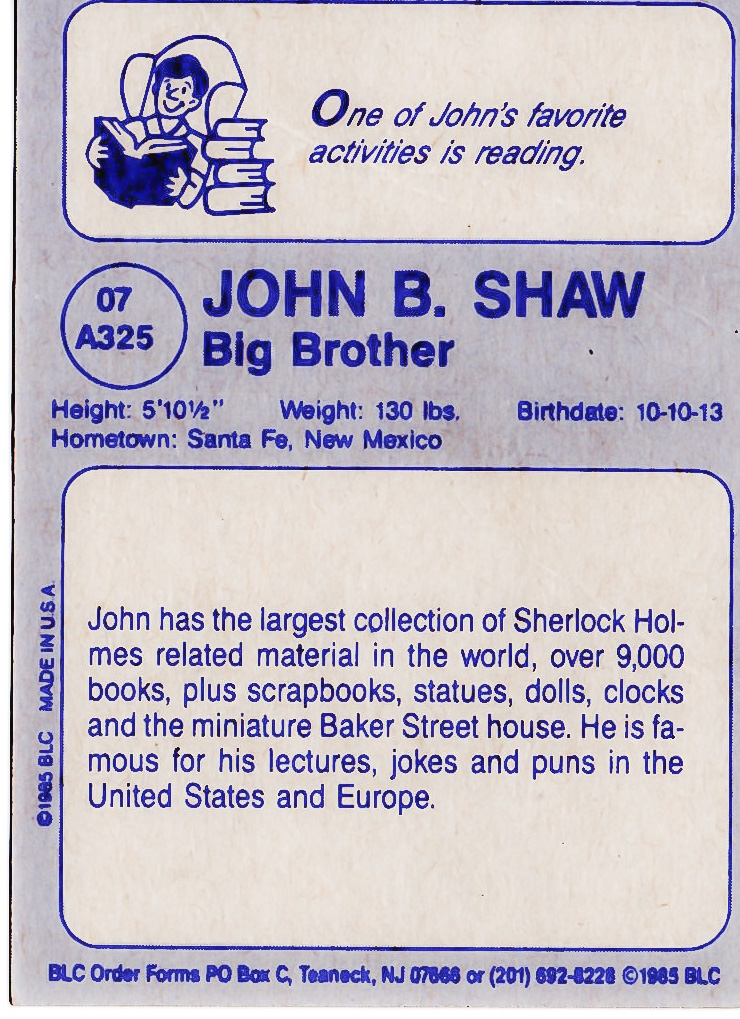
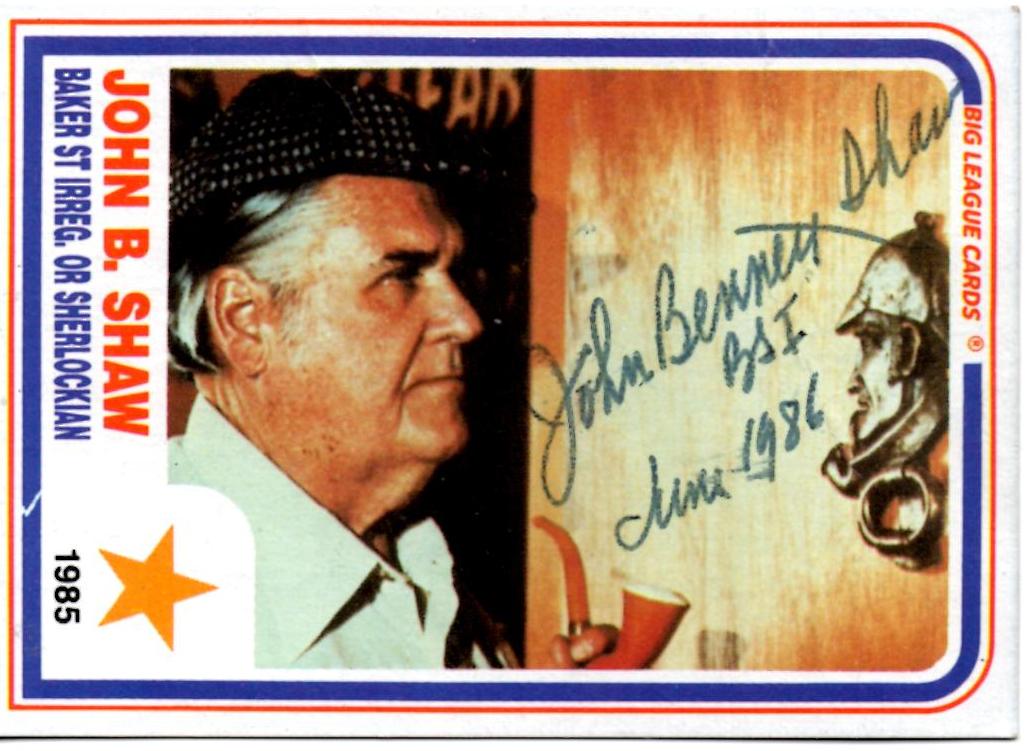
Brothers Three of Moriarty
The Brothers Three of Moriarty
I am convinced one of the reasons Shaw moved to Santa Fe, NM. was because the village of Moriarty was just an hour’s drive south, and around that little town John built his scion, The Brothers Three of Moriarty, which met at the Frontier Saloon. Professor Moriarty was Holmes’ arch enemy, no friend of John Shaw’s. He had enormous fun devising all kinds of scenarios around the name; one of the cleverest was the annual UN-Happy Birthday celebration, an idea that may have been suggested by Martin Gardner’s background with Alice in Wonderland.
And so it began, Shaw’s love affair with New Mexico and the shenanigans he devised around the name of this unsuspecting village of Moriarty.
Sherlockian Sonia Fetherston (BSI - 2014 “The Solitary Cyclist”), a frequent contributor to the Baker Street Journal, visited the village of Moriarty, NM, in 2016 to trace Shaw’s lasting influence.
The name “Moriarty” is synonymous with evil, villainy, corruption and – God help us – math. Or, as Sherlock Holmes beautifully summed it up for Dr. Watson in The Valley of Fear, Moriarty is “in the highest degree sinister.” For the 1,900 souls who call Moriarty, New Mexico their home, however, the name means friendly people, warm welcomes, and unpretentious good humor. Pretty much like Mayberry, only with pinto beans and rattlesnakes. (Download her 11-page BSJ article: The Folks from Moriarty.)
Once he got The Brothers Three going on an “irregular” basis, the UN-Happy Birthday celebrations for (and at) Moriarty followed close behind. The program below is from the 10th Annual UN-Happy Birthday gathering. Presentations were given, toasts were lifted (sometimes with explicit language), a quiz was conducted, songs were sung, and the finale was the “Recessional”: a processional to the Moriarty Memorial with the annual deposit. (More on that below).
VIDEO HISTORY
〰️
VIDEO HISTORY 〰️
The Brothers Three of Moriarty pin has an interesting history. It was shared with me recently by one of the charter members, Saul Cohen. He also GAVE me his pin, the one he received from John Shaw in 1971. He wanted it to go to a “good” JAMES. See the story of that encounter near Santa Fe.
Enjoy this one-page article from 2009 about “Living Treasure” Saul Cohen. The article is here on the internet.
SHERLOCK HOLMES BUFFS PLAN YEARLY MEETING
The Santa Fe New Mexican, Sunday, October 28, 1979
Moriarty Frontier Saloon (All Contents © Copyright The American Southwest)
Moriarty (AP) – One night a year the deerstalker hats replace Stetsons at Moriarty’s Frontier Bar, and country-western music gives way to the rousing strains of “Unhappy Birthday, Moriarty.”
When that happens, the local residents know New Mexico’s Sherlock Holmes fanatics, The Brothers Three of Moriarty, are at it again.
The group—dedicated to perpetuating the legend that Sherlock Holmes is not a legend—plans this year’s salute to the sleuth Thursday. They will gather at 6:30 p.m. in the bar in this small ranching community that shares a name with the great detective’s nemesis, professor James Moriarty.
“The average Sherlockian is doing it for the fun of it,” says Holmes expert John Bennett Shaw of Santa Fe. “It overlaps all social, educational and racial barriers.” The common link is the fictional Victorian-era detective who deduced his way through 60 mysteries, ostensibly chronicled by the ever-faithful Dr. John Watson.
But why Sherlock Holmes?
“He’s real—he’s more real than Richard Nixon,” Shaw says. “Look at today’s heroes. Farah Fawcett Majors, Reggie Jackson…I’d rather believe in Sherlock Holmes.” Shaw, a retired funeral director and longtime library trustee, devotes fulltime to the famous “consulting detective.” He has given lectures and workshops on Holmes all over the world. When he’s home, Shaw spends his days corresponding with other Sherlockians, adding memorabilia to his collection and, when he can, “one-upping” other collectors.
“We’re sort of schizoid, by choice,” he says of the cult. “We’ve all got families, and toilets that back up, but our other leg is in Holmes’ world, which is full of adventure, exciting.”
Shaw believes his is the largest private Sherlock Holmes collection in the world. It numbers more than 4,000 volumes, shelved two deep, floor to ceiling, in an overstuffed room added to his house just for the accumulation. The room isn’t big enough. Shaw laments that he has ore than 50 Sherlock Holmes posters he can’t display. This day’s mail brings yet another, a giant, measuring larger than a door.
About a quarter of Shaw’s book collection consists of volumes about Holmes, including two by dentists who contend the detective’s irascible personality was due to bad teeth or gum disease. Another quarter consists of different English-language editions of Arthur Conan Doyle’s stories, including 85 separate volumes of perhaps the best known, “The Hound of the Baskervilles.” The collection also includes Holmes stories in Braille, shorthand and 39 foreign languages, including Frisian, which is spoken only on the West Frisian Islands north of the Netherlands. Shaw says he “one-upped” other collectors with the Frisian book, because he’s been told it’s the only copy off the islands.
There’s also a limited edition of a copy of five letters written about Holmes by Franklin Delano Roosevelt, the three stories from the library of Czarina Alexandra of Russia. “It’s the best ‘one up’ I’ve got,” Shaw says of the latter. He also has about 50 three-ring binders filled with clippings from 1887 to the present of magazines, newspapers, reviews and even comic strips pertaining to Holmes. Another Sherlockian “made me promise that if the house caught on fire, I’d save those notebooks,” he says.
The collection—acquired over 40 years—also includes statues, busts, pictures, jigsaw puzzles, a Holmes-head walking stick, a Holmes-head pipe, tapes, films, phonograph records and an iron sign proclaiming “221B Baker St.,” Holmes’ London address. Shaw’s prestige license plate even reads “SHERLOK.” He had to drop a letter because New Mexico only allows seven.
Shaw’s wife, Dorothy, a miniaturist and Holmes fan, has been working for three years on a miniature replica of 221B Baker St., complete with Holmes and Watson’s rooms and the rooms of their landlady.
Rarely did a fan of Sherlock Holmes become a full Sherlockian in the presence of John Shaw. But this actually happened to our friend Don Hobbs under the spell of the UN-Happy Birthday, You Bastard, Moriarty! while in New Mexico in 1992. Rob Nunn, the head of the Parallel Cases of St. Louis scion society offered this story in an interview with Hobbs.
Billy Fields, Don Hobbs, Gordon Speck at breakfast during a BSI Weekend in New York (2007)
NUNN: How did you become a Sherlockian?
HOBBS: I had been collecting Sherlockian books for a few years when I received a call from John Bennett Shaw. Somehow he had heard of me and invited me to the 1992 Un-Happy Birthday Celebration in Moriarty, NM along with an invitation to visit him at his Library. That was the crowning weekend where I became a Sherlockian. At the Un-Happy Birthday Celebration, I met John Farrell, Dick Miller, Ron De Waal, Saul Cohen and I decided these were people I wanted to be like.
Recently, in Holmes and Me, a book published in 2021 and edited by Steve Mason and The Crew of the Barque Lone Star, Hobbs shared his article about the call from John Shaw inviting him to visit Santa Fe. It’s a great story, one that points out Shaw’s great heart. It’s a poignant tale of how people became Sherlockians with gentle insistence from the BSI “Simpson.” Don’s essay is When I Became a Sherlockian.
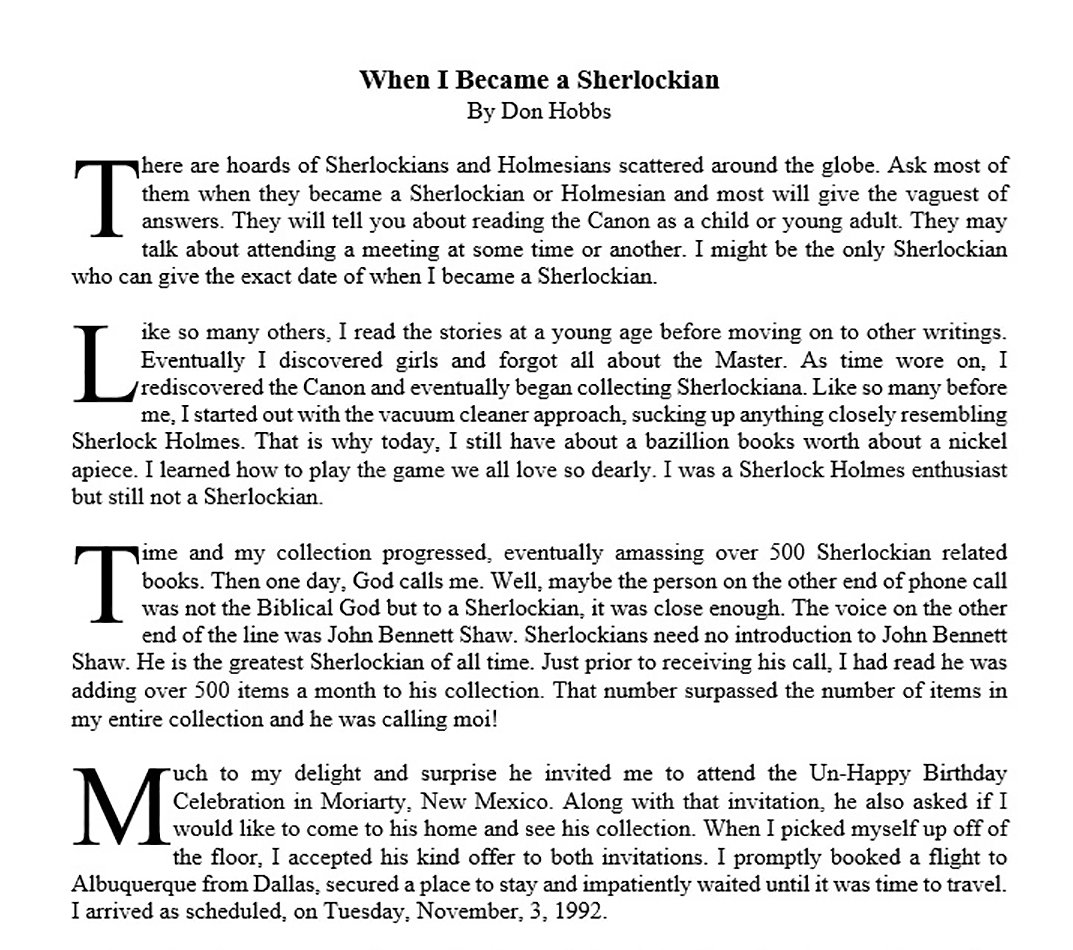
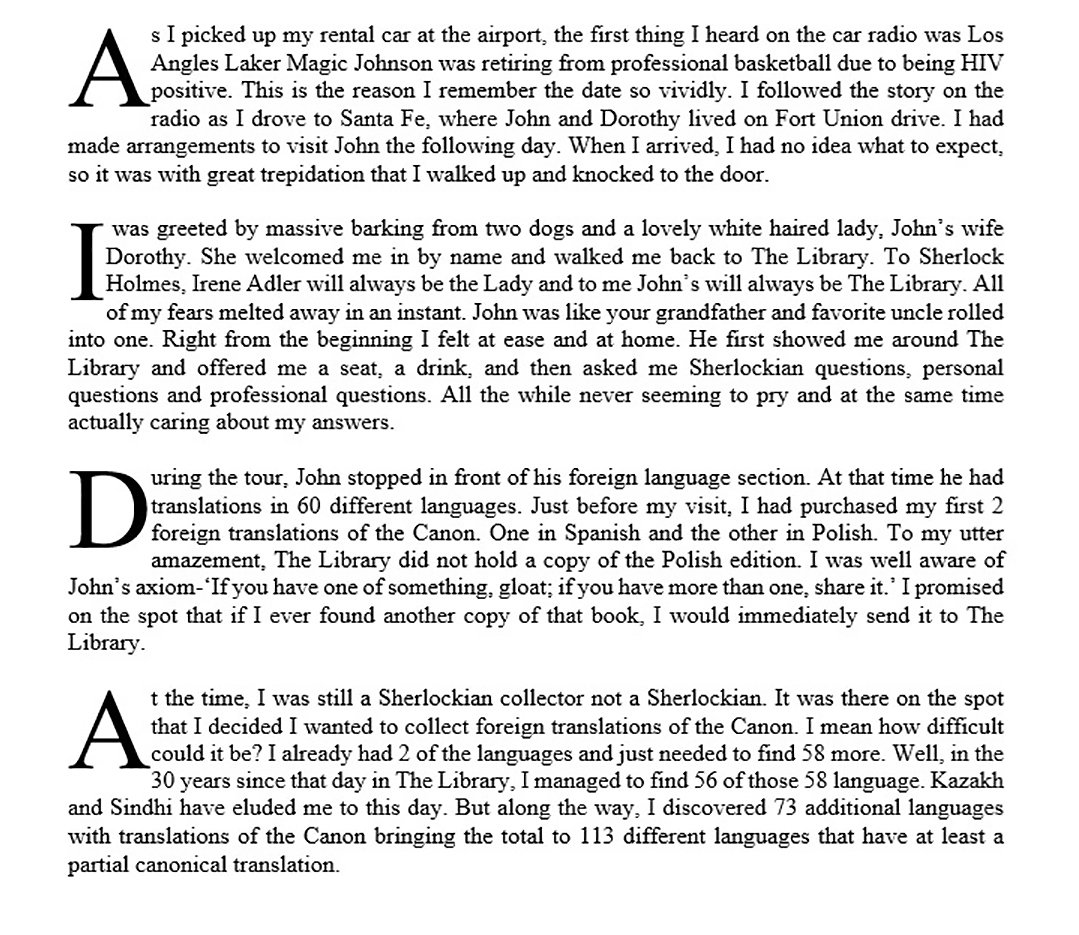

In 1988 John and Dorothy were preparing their annual Christmas Cards for BSI and other Sherlockian friends around the world. John had commissioned an illustration from one of his favorite artists, Jeff Decker of Pennsylvania, for the Annual UN-Happy Birthday Moriarty celebration earlier in the year, but it was cancelled due to a bad case of the flu that put both John and Dorothy in bed. Therefore, John included into the card Decker’s magnificent illustration of himself about to clobber Moriarty (the snake that he was). Here is that illustration. Click on the image to get the full story.
Here is the 10th Annual Un-Happy Anniversary Celebration program Shaw had great fun putting together. He had a few digs for Watson’s reputation with the ladies; a litany, exceedingly clever, of the “sins of Jim”, presumably put together by a “Reverend;” the singing of irreverent songs (hymns?), all brought to an exalted finish with the Recessional, the procession to the Moriarty Memorial with the annual deposits.
The annual UN Happy Birthday Bash
In a letter to Gael Stahl, a charter member of the Nashville Scholars scion society, Shaw had this to say about the 16th Moriarty Memorial Celebration (November, 1987).
Our scion, The Brothers Three of Moriarty, met last Thursday in Moriarty, New Mexico. It was a memorable event, called by many the best meeting we have ever had. Best meaning loudest, wildest, and funniest. Crazy too. Forty-five members and a dozen townies. The locals put on a 30-minute melodrama with Holmes and Watson in Moriarty (a bar of course) 100 years ago. Even had bar girls and so on. The Mayor (was) also there and participating. Our deposits this year included Texas long-horn, Sea Gull and Coyote. Fortunately the wind was blowing out.
An important part of each B3M meeting was the Toasts to various characters in the canonical stories. A rare program from the 2nd Annual meeting has been found recently, and in perfect condition. It is billed as Toasts - proposed and drunk at meetings of THE BROTHERS THREE OF MORIARTY. This became the Christmas card for John and Dorothy Shaw in 1972. Here is the complete program.
The Twentieth Gathering of the Brothers Three of Moriarty
November 3, 1994
Remembering Big Brother
As we know, John Bennett Shaw “passed beyond the Reichenbach” on October 3, 1994. One month later the Brothers Three of Moriarty met to remember and pay respects to their Big Brother. One of the charter members, Saul Cohen, kept a copy of that program and gave his permission for us to share it here. The artwork was chosen from illustrations Jeff Decker had done for John in previous years. The one showing elephants carting all of his books to Minneapolis from the mountains around Santa Fe was a favorite of his. This is the first time most Sherlockians who were not at this scion meeting have ever seen this “Remembering Big Brother” program, the Twentieth Brothers Three meeting.
On the inside page of the program you see Jeff Decker’s final statement on Shaw’s dislike for Professor Moriarty. Holmes and Moriarty are in their death struggle at the Reichenbach Falls, and baby Shaw is about to clobber the Professor with a hammer. John “hammered” Moriarty every way he could and at every opportunity.
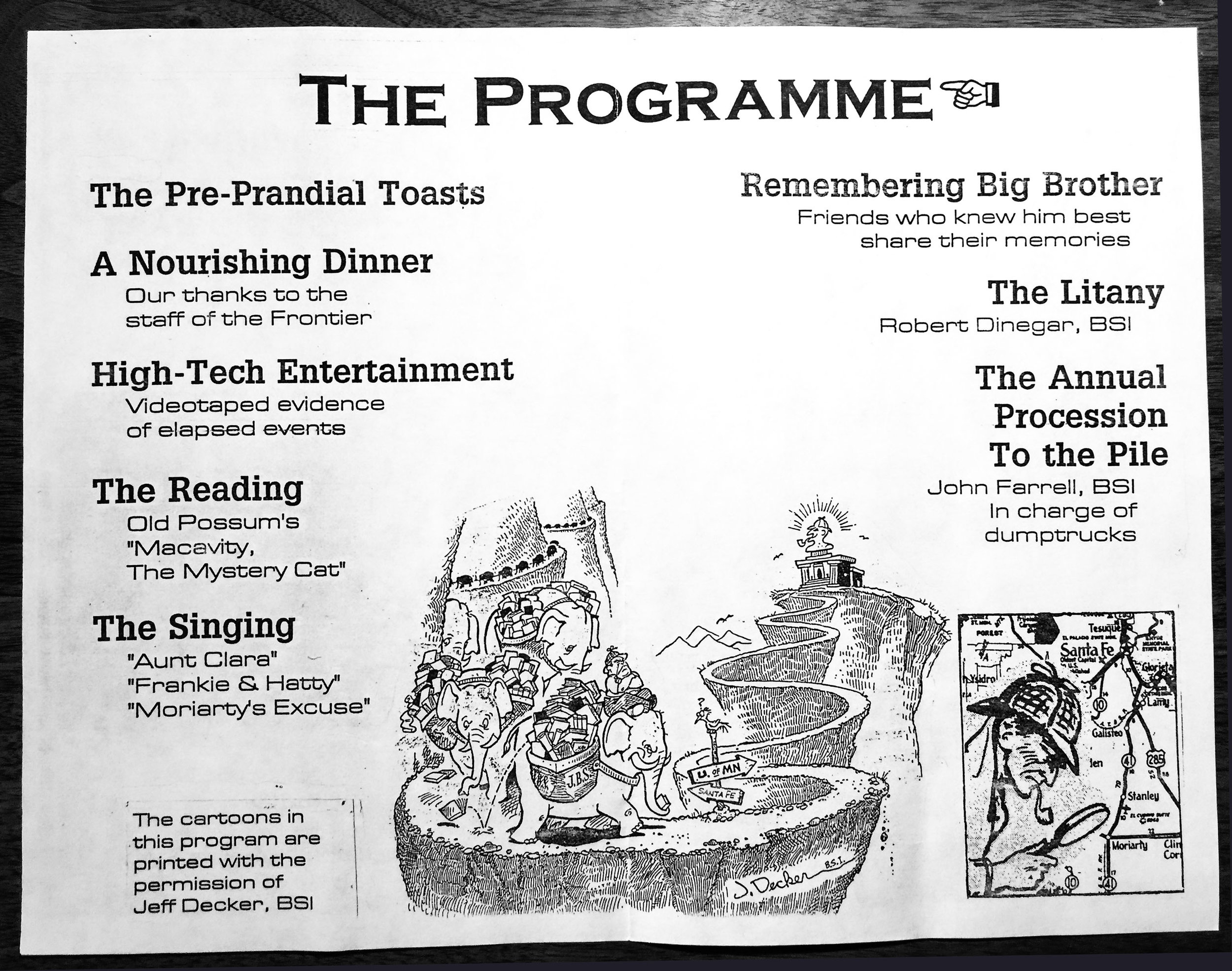
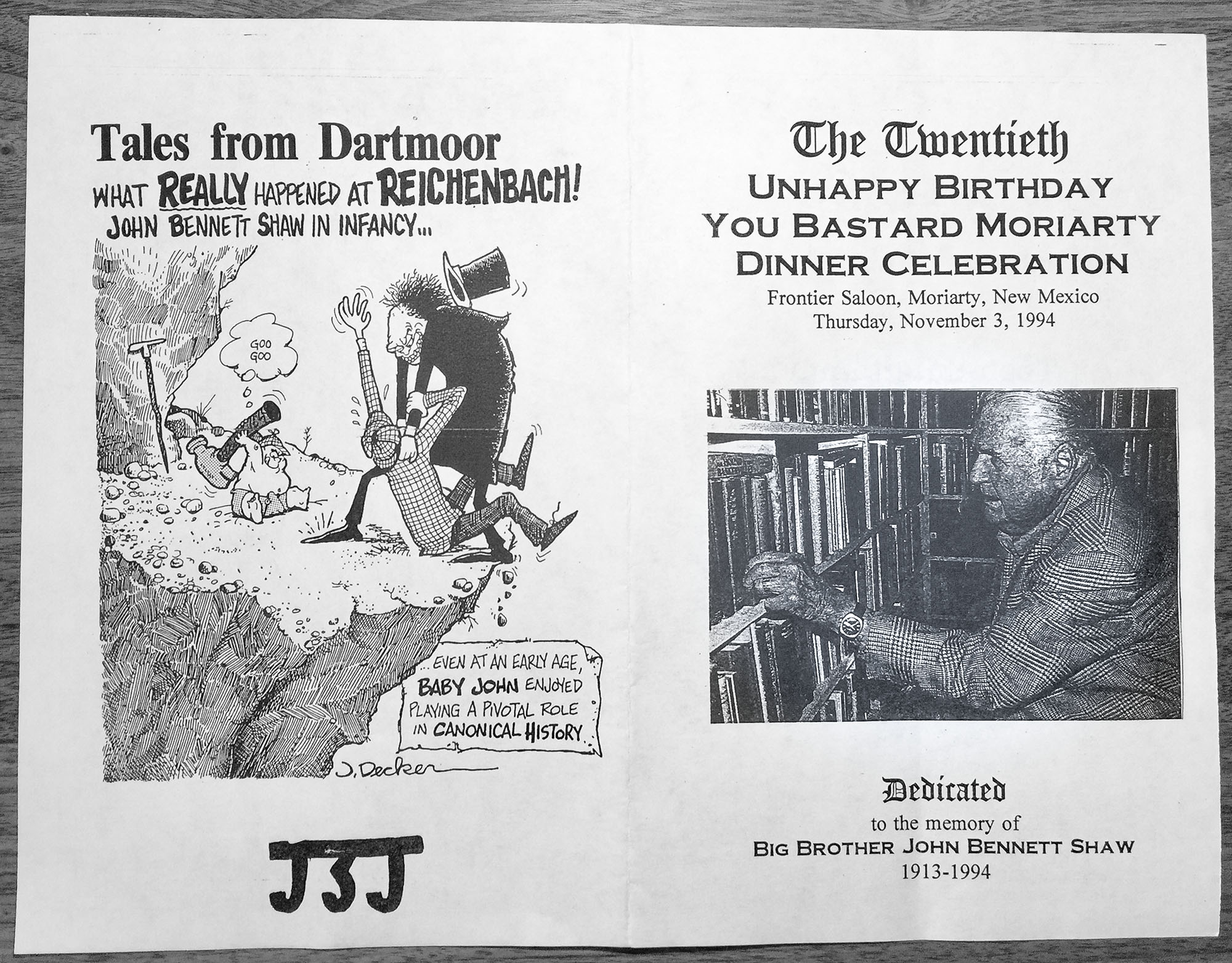
There are so very many friends to thank for their contributions to the Friends of John Bennett Shaw Facebook page, and subsequently to this website. Let me mention several (behind the scenes) encouragers without whose assistance this project never would have been possible.
A Special Thank You to these :
Mattias Boström, author of From Holmes to Sherlock (Grove Atlantic, 2013),
who gave me the spark I needed to attempt this dream.
Tim Johnson, Curator of Special Collections & Rare Books / E. W. McDiarmid Curator of the Sherlock Holmes Collections, University of Minnesota Libraries, who opened the library resources to me and made the outpouring of others possible.
Jon Lellenberg,, for years a defense policy and strategy official at the Pentagon in Washington, DC, and the author of numerous books on the history of the Baker Street Irregulars, sent lots of information, encouraged me to write, and introduced me to Saul Cohen, the oldest surviving member of the Brothers Three of Moriarty. (Note: Cohen is a well-known attorney in Santa Fe and active in the local Jewish community. See this article about him in Santa Fe Living Treasures magazine from 2009. And, sadly, Jon Lellenberg died in April of 2021 after a brief illness.)
Steven Rothman, editor of the Baker Street Journal, who signed on early, was generous with resources, and stayed enthusiastically behind the project.
Dean Richardson, co-editor of the Nashville Scholars newsletter, Plugs and Dottles,
was kind enough to edit all the text on this website. Any mistakes are mine, not his.
Airing on June 30, 2019 was an interview with Scott Monty and Burt Wolder,
hosts of the podcast, I Hear of Sherlock Everywhere about how this website
came to be. You can access the interview here.
Other important people are mentioned (and pictured) in the text of the website.
My sincere thanks to each.
Resources: Listen to an interview with Scott Monty and Burt Wolder, hosts of the podcast, I Hear of Sherlock Everywhere. Also an article by Jim Hawkins for the Saturday Review of Literature giving the reasons for and the steps taken in producing this website to honor and remember John Bennett Shaw, on the Nashville Scholars’ website.
A recent edition of Steven Doyle’s Fortnightly Dispatch, interviews by and about significant Sherlockians, featured four men who knew John Bennett Shaw and were admirers and friends. See the video here on You Tube. The series is produced by Steven Doyle for the Baker Street Irregulars.
